



















12 The fashion guru and the ideawale baba of Indian cricket
An interesting conversation session with celebrated cricketers Zaheer Khan and Yuvraj Singh at the D 3131 conference.
28 Zones 4 & 5 among the top 9 in TRF giving
A summary of the Foundation Seminar at the KL Zone Institute.
35 Rotary makes mammography mobile RC Amravati Midtown’s endeavour to save women from cancer.
36 My Rotary One Rotary
An account of the round-thecountry car rally by Pune Rotarians.
48 Cycling their way to empowerment
20 Money was never my priority
An interview with TRF Trustee Chair Paul Netzel.


32 Ensure continuity of leadership
RID John C Matthews shares some valuable tips with the DGEs at the GETS session at the KL Zone Institute.
Rotarians from RC Pune Shivajinagar motivate girls to ride to school on their own bikes.
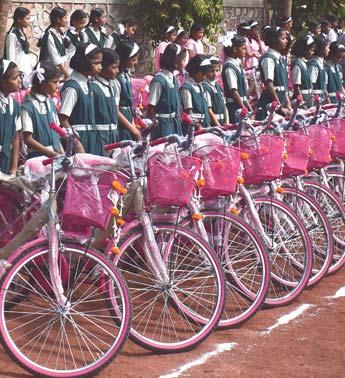
70 Let emotional mists dissolve Find out how you can enjoy inner peace and rise above your insecurities.
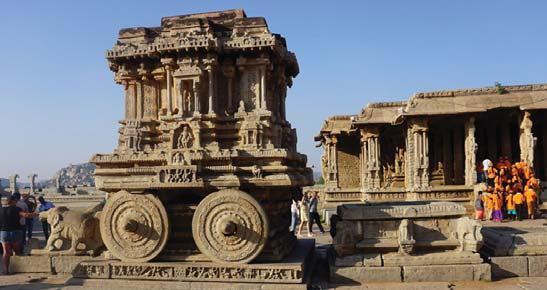
52 The breathtaking ruins of Hampi Transcend to a different era as you explore the richness of the Vijayanagara capital.
On the cover: D 3202 DGE E K Ummer with other delegates at the International Assembly.
Photo Courtesy

Ihave before me the January issue and I am impressed by the regularity in publication, the choice of subjects, narration, overall design and layout. While all the articles are worth reading, Cut out the extravaganza and fuss written by Rasheeda Bhagat is superb. This is what Rotarians, in and outside Rotary meetings/ events, say in whispers. To put out that in an article speaks highly of the boldness of the writer. We need to take the observations of Usha Saboo as food for thought and action. The kind of extravaganza and fuss in Rotary meetings must be replaced by simplicity and service-orientation, not in words but action.
We must not forget that we are a service organisation to help the community. Congrats to the Editor and her team.
C K Sardana, RC Bhopal Midtown — D 3040
Rotarians in India must read the article Frankly Speaking in the January issue as the topics discussed are serious and disturbing. It is a shame that even now Rotary clubs resort to underreporting of membership with impunity. Also, the election of district governors, in spite of many changes brought by RI, is fought with money power and tall promises, as a result of such behaviour, says PRIP Rajendra Saboo, the good work done by Rotarians in India is lost. Also, when district programmes — PETS, SETS, etc — are held outside, even in foreign countries, it puts a lot of financial pressure on the presidents and secretaries-elect for travel. Because of
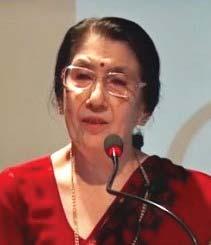
the service rendered by Usha Saboo, a non-Rotarian and the spouse of PRIP Rajendra Saboo for the last 57 years. She has made frank and honest admissions on the “extravaganza and fuss at the district conferences”, and has done great service to Indian soldiers by sending sweets to them on Diwali-eve. At the age of 82, she has passion to serve humanity. Kudos to Madam Usha Saboo. Dr D Harischandra Rama RC Anantapur — D 3160
this Rotarians are unwilling to take up the post of president and secretary. Also, many districts publish a huge directory of 500 pages (sometime in two volumes) on glossy paper. This requires finance and the AGs and presidents have to get ads. In this era of paperless communication this is a big waste. A good website of the district can contain such information. There is no transparency in using DDFs, and TRF should look into the matter.
R Sivaramakrishnan RC Trivandrum North — D 3211
Well crafted, striking Editorial My hearty congrats for your January Editorial which can be termed as a magical box with a
number of messages crafted in a subtle way, including the statements of top Rotarians that strike the mind hard. Our “love to complain and shoot off a letter, with copies to everyone around the world” must be stopped. Instead, we should seek solution in a dignified way without the cyber route.
Dishonesty in reporting of membership figures and absence of women business and professional leaders are issues that deserve priority. The “4-Way Test is not something, you just put up on a wall,” said the RI President most aptly.
V K Bansal
RC Delhi Uptown — D 3012
Thecoverage of the international project of RC Jersey City with my club is excellent. The write-up Global grant project transforms schools will enable RCJC to appreciate the care we have given to their prestigious project in India. I thank Rotary News for bringing out the magazine with such care.
Pradeep Wagh
RC Pune Shivaji Nagar — D 3131
RI Director C Basker’s message — Let’s serve through our vocation — is an eyeopener, particularly for those retiring in the near future, as how to remain active during our retired life. The example of 76-year-old Kalyanasundaram who donated his entire income and ` 30 crore award for the welfare of orphans is an exceptional example of service. All articles in the January issue, notably Cut out the extravaganza and fuss and Saboo’s 10-point message on leadership, make good reading. Congrats to Team Rotary News for sustaining the magazine’s standard.
M T Philip, RC Trivandrum Suburban — D 3211
Iam happy to note that the GETS sessions at the KL Institute were
well-planned and executed under the leadership of PDG Sam Movva. He said that RI Director C Basker wants to continue this training cycle at the district level. Congratulations to Sam and his team from D 3020 and hats off to Baskar and the event Chairman R Theenachandran for making the KL Institute a grand success.
N Jagatheesan RC Eluru — D 3020
More strength to small clubs
Asuccessful leader must have three qualities — planning, monitoring and personal contribution. Readers will agree that Rasheeda Bhagat has all these attributes. That is why she can give us such an attractive magazine covering all walks of life. An excellent writer, she possesses the artistic caliber which is visible from the fantastic photographs and their placement. The cover photograph of the December issue is an example.
To reach out to the small clubs is indeed a laudable decision to keep up their morale. RI President Ian Riseley said Rotary is better placed than ever to have a real and lasting impact on peace through every area of service. Water, sanitation, health, education and economic development, can all avert conflict.
PRIP Kalyan Banerjee has correctly said, “Rotary has the tenderness, the softness, the kindness of a parent and the strength of a Government.”
RC Banglore deserves appreciation for renovating 106 Government primary schools and providing them with infrastructure and modern amenities, thus transforming them into Happy Schools with all facilities on the checklist.
Each word of Dr Soumya Swaminathan ( Let RI take up the challenge of eradicating TB ) is readable and thought provoking. After
conquering polio, tackling TB should not be a difficult task if Rotarians join hands.
Raj Kumar Kapoor RC Roopnagar — D 3080
Youhave done an excellent coverage of Setubandhan , the multi-district conference at Agartala. The article as well as photo feature Building a bridge and the write-up on the untiring efforts of Hospet Rotarians in serving the community through their eye bank and dialysis centre are laudable.
I am proud that RC Tinnevelly turns 75 this year. Being its member I know the good projects being done by the club. My hearty congratulations to them.
The steps taken by you to focus on smaller, energetic clubs that are far away from Chennai, as indicated in your Editorial, are well-timed and in the right direction.
S Rangarajan, RC Tirunelveli Suburbs — D 3212
Asalways, I eagerly waited for the December issue and found you have covered many subjects. Yes, Northeast is really a wonderful place as we lived two years in Shillong. Keep up the good work.
Group Captain Deodhar RC Nasik – D 3030
Itwas good to read the cover story on Sethubandhan, and see the event featured on the magazine’s cover with a good photograph clicked at the Rabindranath Tagore auditorium with a tagline “In Tagore’s footsteps”. It would have been apt if you had given a brief write-up on the Nobel laureate who is immortalised for giving our national anthem.
A L Perianan Shanmugam
RC Madurai Midtown — D 3000
Ashift in policy to go pan-Indian on the part of Rotary News will positively and drastically boost the small clubs hitherto neglected as they were overshadowed by big projects. Your introspective vision is seen in every issue of the magazine having some novelty with articles on proactive changes in Rotary. Your ideas and convictions are expressions of a real ambassador of Rotary.
Rasheeda Bhagat’s article Let RI take up the challenge of eradicating TB is laudable as Rotary has done a commendable job in eradicating polio from India and many other countries. Now it is time to focus on TB.
Prof Shiv Sethi, RC Ferozepur Cantonment — D 3090
Strong message from RI leadership
TheDecember issue highlights the saying “Great people think alike” as the three RI icons — President Ian Riseley, Director C Basker and Trustee Chair Paul Netzel — concentrated their messages on three projects. The President said the world should be a peace-loving place wherein “no scourge of war” is visible. Rotary is a suitable platform to provide lasting peace in the world through its Rotary Peace Fellows programme. Director C Basker said India has the second largest number of diabetics and hence diabetes detection camps should be organised in their districts. Netzel stressed the power of partnerships.
RC Jalna Midtown, D 3132, has come out with two great projects ( Shuddha Jal , November issue) for purifying drinking water. I appeal to all Rotarians to implement these projects so that students and villagers can be assured of potable water.
G V Sayagavi, RC Davanagere Vidyanagar — D 3160
We welcome your feedback. Write to the Editor: rotarynews@rosaonline.org; rushbhagat@gmail.com
RI Dist 2981
DG P S Ramesh Babu
RI Dist 2982 DG Dharmesh R Patel
RI Dist 3000 DG P Gopalakrishnan
RI Dist 3011 DG Ravi Choudhary
RI Dist 3012 DG Sattish Singhal
RI Dist 3020 DG G V Rama Rao
RI Dist 3030 DG Dr K Sunder Rajan
RI Dist 3040 DG Dr Zamin Hussain
RI Dist 3053 DG Rajkumar Bhutoria
RI Dist 3054 DG Maullin Manubhai Patel
RI Dist 3060 DG Ruchir Anirudh Jani
RI Dist 3070 DG Parvinder Jit Singh
RI Dist 3080 DG T K Ruby
RI Dist 3090 DG Bagh Singh Pannu
RI Dist 3110 DG Vinay Kumar Asthana
RI Dist 3120 DG Ranjeet Singh
RI Dist 3131 DG Abhay Gadgil
RI Dist 3132 DG Vyankatesh Vithal Channa
RI Dist 3141 DG Prafull J Sharma
RI Dist 3142 DG B M Sivarraj
RI Dist 3150 DG J Abraham
RI Dist 3160 DG Madhu Prasad Kuruvadi
RI Dist 3170 DG Anand G Kulkarni
RI Dist 3181 DG M M Chengappa
RI Dist 3182 DG G N Prakash
RI Dist 3190 DG Asha Prasanna Kumar
RI Dist 3201 DG Vinod Krishnan Kutty
RI Dist 3202 DG Sivashankaran P M
RI Dist 3211 DG Suresh Mathew
RI Dist 3212 DG Chinnadurai Abdullah
RI Dist 3231 DG Jawarilal Jain K
RI Dist 3232 DG R Srinivasan
RI Dist 3240 DG Sunil Saraf
RI Dist 3250 DG Vivek Kumar
RI Dist 3261 DG Harjit Singh Hura
RI Dist 3262 DG Ajay Agarwal
RI Dist 3291 DG Brojo Gopal Kundu
Printed by Mukesh Arneja at Thomson Press (India) Ltd, Plot A-9, Industrial Complex, Maraimalai Nagar 603209, India and published by Mukesh Arneja on behalf of Rotary News Trust from Dugar Towers, 3rd Flr, 34, Marshalls Road, Egmore, Chennai 600 008. Editor: Rasheeda Bhagat.
Board of Permanent Trustees & Executive Committee
PRIP Rajendra K Saboo RI Dist 3080
PRIP Kalyan Banerjee RI Dist 3060
PRID Sudarshan Agarwal RI Dist 3011
PRID Panduranga Setty RI Dist 3190
PRID Sushil Gupta RI Dist 3011
PRID Ashok Mahajan RI Dist 3141
PRID Yash Pal Das RI Dist 3080
PRID Shekhar Mehta RI Dist 3291
PRID P T Prabhakhar RI Dist 3232
PRID Dr Manoj D Desai RI Dist 3060
RID C Basker RI Dist 3000
Executive Committee Members (2017–18)
DG B M Sivarraj RI Dist 3142
Chair – Governors Council
DG R Srinivasan RI Dist 3232
Secretary – Governors Council
DG Abhay Gadgil RI Dist 3131
Secretary – Executive Committee
DG Vivek Kumar RI Dist 3250
Treasurer – Executive Committee
DG P Gopalakrishnan RI Dist 3000
Member – Advisory Committee
Editor
Rasheeda Bhagat
Senior Assistant Editor Jaishree Padmanabhan
Send all correspondence and subscriptions to
ROTARY NEWS TRUST
3rd Floor, Dugar Towers, 34 Marshalls Road Egmore, Chennai 600 008, India.
Phone : 044 42145666 e-mail : rotarynews@rosaonline.org
Website : www.rotarynewsonline.org
The views expressed by contributors are not necessarily those of the Editor orTrustees of Rotary NewsTrust (RNT) or Rotary International (RI). No liability can be accepted for any loss arising from editorial or advertisement content. Contributions – original content – are welcome but the Editor reserves the right to edit for clarity or length. Content can be reproduced, but with permission from RNT

Very often when we see celebrities, particularly professional sportspersons who reach the pinnacle of their particular sport and play the game so effortlessly, we tend to miss the trauma and pain, grit and determination, long and silent suffering that are hidden somewhere in the aura of the famous person. Hence the peppy and frank conversation that Indian cricket’s two stalwarts — Yuvraj Singh and Zaheer Khan had with Vikram Sathaye in Pune during a session at D 3131’s district conference was as absorbing as it was an eye-opener. Of course the dashing Yuvi’s penchant for fashion and a hep dressing style was reinforced, as also the suave Zaheed Khan’s entrepreneurship skills which have helped him launch several restaurants and ProSport fitness centres. But we also learnt of the deep bond of friendship that exists between the two and how Zak, as he is called by his teammates and friends, pushed Yuvraj to overcome his stiff neck and all kinds of injuries and excruciating pains, and literally commanded him to go out and play in the 2011 World Cup and get glory for India and himself. Yuvraj recalled that a year earlier, in Bangladesh, he had broken his wrist, and even earlier, sustained some 4–5 fractures in a row. “My neck was stiff, I had all kinds of problems with my body and talked to Zak about the physical challenges I was facing. I thought he will say go see a good doctor but he said ‘Tu world cup jitayega. (You will get the World Cup for India)’ I said bro, the World Cup is in a year. And he said bus bol diya (I’ve said it).”
Even while scowling at this “weird advice from a friend”, he decided to play. The World Cup started; he
spent sleepless nights due to the pain and pressure and he told Zak he wasn’t going to back out. But again he said “tu match khel.” He did and got the first 50 of the World Cup, followed by another three 50s and a 100 and a 50 in the quarter finals. But battling cancer and emerging triumphant to return to Indian cricket was much more serious. “It was about whether I would survive or not. The question of life ending is very serious. And after going through this battle, injuries now seem like getting temperature and taking Crocin to fix it,” he said amidst huge applause.
On his persistent shoulder injuries Zaheer said that after detailed chats with sports psychologists and through personal experience he had learnt that shorter the time one spent on each of these phases, the quicker was the recovery. After his shoulder surgery in 2008–09, he thought his career would end because 80 per cent of his bowling action comes from the shoulder. This put him in “a very negative mind zone,” but then during rehab, he’d put his hand on his shoulder to transfer healing and positive vibes, and it worked!
They are of course national icons, but I’m sure each of us, in our personal lives, can tell stories of ordinary people who have displayed extraordinary courage when faced with pain, disease, death. They are heroes too. And if we talk of gender, and celebrities of a lesser god, my vote would go to the feisty captain of the Indian women’s cricket team Mithali Raj. When asked the same clichéd question by a reporter on who her favourite male cricketer was, she quipped: “Do you ask the same question to a male cricketer? Do you ask them who their favourite female cricketer is?” Touché!
Rasheeda Bhagat

Dear Fellow Rotarians,
One hundred thirteen years ago this month, the four members of Rotary’s first club held their first meeting. Although no minutes were kept, it’s unlikely anyone talked about service; the club did not begin focusing on the needs of the community for another few years.
days. The Rotary of today, more than 1.2 million members strong, lets us feel at home not only in a small group of our peers, but also in our diverse clubs, across our communities, and indeed throughout the world. Today, Rotary connects us all in a way that Paul Harris could never have dreamed on that February evening so long ago. Not only can we go anywhere in the world there is a Rotary club and feel at home, but we can reach out to anywhere in the world there is a Rotary club and make a difference.
The meeting was held not in a hotel or a restaurant, but in a member’s office; there were, so far as we know, no agendas or announcements, no committee reports, speakers, or name tags. The meeting would have failed today’s usual standards for a productive Rotary meeting most resoundingly. It was, of course, the most productive Rotary meeting ever held.
odays usual standards
ng s t y us
In the 113 years since that first meeting, Rotary has become far larger, and more diverse, than those founding members could have conceived. We have gone from an organisation that was all white and all male to one that welcomes women and men of every possible background. We have become an organisation whose stated purpose is service, reflected in our motto, Service Above Self. And we have become not only an organisation that is capable of changing the world, but one that has already done so, through our work to eradicate polio.
soug h t: f r i en d s hi p, l at home. But ore than it could ever mbers in those earliest
Today, as in 1905, many of us come to Rotary seeking what Paul Harris sought: friendship, connections, a place to feel at home. But today, Rotary gives us so much more than it could ever have given its earliest members in those earliest
None of us can know what lies ahead for Rotary. It remains for all of us to continue to build on the solid foundations that were laid for us by Paul Harris and his friends: to forge and strengthen the bonds of service and friendship through Rotary: Making a Difference.

President, Rotary International
Ian H S Riseley ent, Intern


Dear Rotarians,
February is an important month as Rotary was founded in this month. We have been celebrating this month as Peace and Conflict Prevention/Resolution Month. Friends, let us first ask ourselves what is peace. Peace reigns when people are able to resolve their conflicts without violence and work together to improve the quality of their lives. Peace is when everyone has fair and equal access to basic needs for their wellbeing — food, clean water, shelter, education, healthcare and a sustainable living environment. Peace is when everyone has an equal opportunity to work and make a living, regardless of race, colour, caste, creed, gender, ethnicity and other parameters of identity.
Conflict is generally associated with negative encounters. Let us realise that conflict fosters an awareness that problems exist. In 1982, for the first time, the World Understanding and Peace Committee discussed ways to promote greater understanding and peace in the world. Before the formation of the Peace Programmes, Rotary has served to promote goodwill between the countries of South America. For example, much ill-will existed between Peru and Chile for nearly 50 years after the War of the Pacific. There were no points of contact and all relations, including diplomatic and trade between the countries were suspended. The Rotarians of Chile took the initiative to send Christmas greetings to their counterparts in Peru. In response, Peruvian Rotarians sent New Year greetings and through this simple gesture a door was opened and a channel created for the resumption of cordial relations between the two countries.
During the war in Gran Chaco, the Rotary Clubs of La Paz, Bolivia, and Asuncion, Paraguay, looked after the prisoners of war in their respective countries, with some Rotarians in Argentina acting as go-betweens. This work was praised by
the Red Cross, and helped bring about closer relationship between these countries after the efforts of several Rotarians serving on the Peace Commission. Several prominent South American Rotarians have commented that during the period of the war, a Rotary lapel pin often served as a safe “passport” while travelling between the hostile neighbouring countries.
Rotary makes amazing things happen in a variety of ways. Whether through our service projects or peace fellowships and scholarships, our members are taking action to address the underlying causes of conflict, including poverty, inequality, ethnic tension, lack of access to education, and unequal distribution of resources.
Rotarians must follow the 6th century BC Chinese philosopher — Lao Tzu’s words : “There must be peace in the heart.” It is only selfless work that brings peace in the heart and we can achieve this by extending a helping hand to the needy and working for the welfare of our communities.
If there is to be peace in the world, There must be peace in the nations.
If there is to be peace in the nations, There must be peace in the cities.
If there is to be peace in the cities, There must be peace between neighbours.
If there is to be peace between neighbours, There must be peace in the home.
If there is to be peace in the home, There must be peace in the heart.
Let us work to achieve peace and show the world Rotary: Making a Difference.

C Basker Director, Rotary International

n Feb 23, Rotarians will celebrate World Peace and Understanding Day — the 113th anniversary of Rotary’s founding.
Peace has been at the core of our organisation from its earliest days. We established the Fourth Object of Rotary in Edinburgh, Scotland, in 1921. We were in London when the seeds were sown for what became UNESCO after World War II. In Havana in 1940, we adopted a resolution calling for “freedom, justice, truth, sanctity of the pledged word, and respect for human rights,” which became the framework for the United Nations’ Universal Declaration of Human Rights in 1948.
We were active in the formation of the United Nations. In 1945, almost 50 Rotarians served as delegates, consultants, and advisers at the San Francisco Conference when the UN charter was written. Today, almost 73 years later, Rotary maintains the highest consultative status with the United Nations of any nongovernmental organisation. A number of our Rotary Peace Fellows work in the UN agencies. Rotary’s representatives to the UN also host a Rotary Day every November to celebrate our partnership for peace.
Today we also have a new partnership with the Institute for Economics and Peace, which
was founded in Australia by tech entrepreneur Steve Killelea. The institute emphasises what is called positive peace, based on eight “pillars”: a well-functioning government, a sound business environment, equitable distribution of resources, acceptance of the rights of others, good relations with neighbours, free flow of information, high levels of human capital and low levels of corruption.
Between now and June, we have the opportunity to participate in Rotary President Ian H S Riseley’s Presidential Peacebuilding Conferences in six cities across the world. Take a look online at rotary. org/ presidential-conferences . We will continue to explore how the eight pillars of peace align with our areas of focus.
We also are joining with the University of Chicago to host Pathways to Peace, a series of talks featuring leading scholars, practitioners, Rotary Peace Fellows and thinkers in the field of peace and conflict prevention and resolution. Watch the first one, which was held in September, at bit.ly/2j9cSUh.
Together with our partners, we will work to establish ourselves as global thinkers and leaders to advance understanding, goodwill and international peace.
Let us work together on this journey.
Paul A Netzel Foundation Trustee Chair
I want to hear about your peacebuilding projects. Share with me at Paul.netzel@rotary.org.


The most scintillating and enjoyable session of D 3131’s district conference in Pune titled adhyay18 was arguably the one in which Indian cricket’s two most celebrated cricketers Yuvraj Singh and Zaheer Khan were interviewed by Vikram Sathaye. Apart from being extremely articulate and good friends, the two

Rasheeda Bhagat

share a common point in that they’ve faced physical challenges — Singh much more than Khan as the former went through a grim battle with cancer — but have refused to be daunted by them and give in.
The conversation, aptly handled by Sathaye, revealed multiple facets of the cricketers and proved to be peppy with some interesting tidbits of their colleagues being shared.


For one, we found that Khan, or Zak as he is called by his friends and colleagues, has a terrible sense of fashion and “on dressing, he definitely takes advice from me. Now of course, as he sits on Star Sports as a commentator, he has to wear proper clothes. Earlier, he’d come and ask me: ‘Yeh jacket kaisi hei?’. And I’d say ‘Zak, nahiyaar please,” said Yuvraj. And the same was true of his shirt and belt “So every time we went out, he was wearing either my shirt or belt!”
Quick to confess, Zaheer added, “I’ve hardly bought belts; almost all of my belts come from Yuvi because he has the best belts in his wardrobe!”
Yuvi the wonder fielder
Next, Yuvraj was asked to divulge the secret of his great fielding at a time when only the batsmen and bowlers were noticed and patted. When asked by Sathaye to reveal how he learnt to dive like Mithun Chakravarthy, Yuvi revealed that he would keenly watch Jonty Rhodes while he was 15 or 16. “He would simply dive and I wanted to fly like him on the field.” But his firstclass cricket debut at 16 was marred by a couple of misfields. “I have kept that clipping till today, where I was called the Gateway of India! My dad read it, took it very seriously, as he does anything related to me, and ensured that in every practice session I catch some

“I have kept that clipping till today, where I was called the Gateway of India! My dad took it very seriously, and ensured that in every practice session I catch some 50 to 100 balls and I learnt to move quickly.
Yuvraj Singh

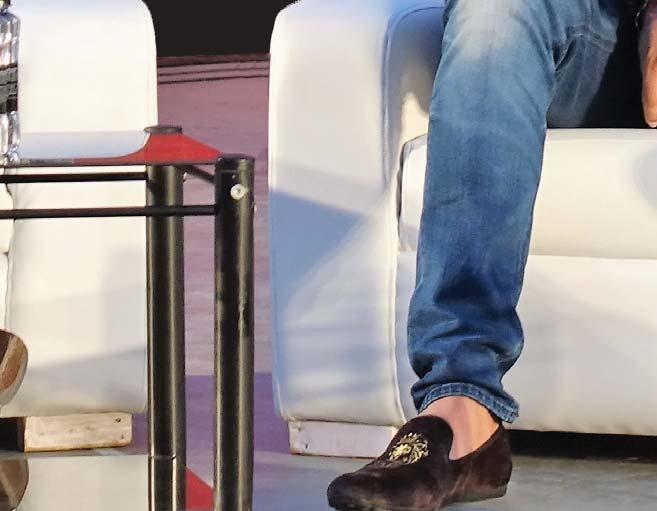

50 to 100 balls at least. So I worked very hard on the field; I’m not a natural fielder but learnt to move quickly.”
But Zak is considered a safe catcher, and here Yuvi related the anecdote of a match in New Zealand where the winds tend to be very strong. “So Zak was bowling and the ball went up and he said ‘Mine.’ But as the ball came down near me, he said, ‘Yours!’ I dived, touched the ball and it fell to the ground.”
Added Zak, amidst peels of laughter, “But it’s not an exaggeration; in Wellington the breeze is so strong that the ball swings in the air… it’s very hard to explain!”
A good part of the session was devoted to mind games; how a bowler can be extremely precise and make the batsman act to his will. Quoting Sachin Tendulkar, who had said Zaheer Khan was “the most intelligent bowler as he makes the ball talk, and is always trying to plot a batsman out,” Sathaye asked: “Tell us how you do it.”
Khan said knowing what would be difficult for the batsman was crucial. “Sometimes, even if you bowl to your strength, you are not going to get the desired results. You have to play on the batsman’s weakness, which everyone knows but to get results you have to prepare.”
His preparation would start by analysing videos and always looking at how the batsman moved his feet. “If his feet are moving well, that means he is not thinking about a whole lot of things and if the partnership is happening, you need to be smart and have to

about the 2011 World Cup where he did extremely well, and the events before it, Yuvraj Singh recalled that a year earlier, in Bangladesh he had broken his wrist. “Before that I had 4–5 fractures in a year and had an issue with my neck and all kinds of problems with my body. I talked to Zak about the huge physical problems I was facing and asked him what I should do. I thought he will say go see a good doctor or use such an ointment. But he said ‘Tu world cup jitayega. (You will get the World Cup for India)’ I said bro, the World Cup is in a year. And he said bus bold iya (I’ve said it). I felt quite weird that this is not the right kind of advice a friend would give you.”
But then the World Cup started; his health was in bad shape and he spent sleepless nights due to the pain and pressure. His neck was killing him “and I told Zak I can’t play as I can’t face the bowler and will tell Gary I can’t play. But he said, no, play this match. I said I can’t because my neck is stuck and I stand the danger of getting the ball hit on my head. But he was adamant and said nahi tu match khel. So I got more irritated with him… but his answers are like that only!”
You have to pressurise a batsmen to commit a mistake. How many times have you seen a batsman getting out on a really good ball? Mostly batsmen get out because of the mistakes they make.”
Zaheer Khan
Yuvraj said things were so bad with him that while the national anthem was playing he had no choice but to run to the physiotherapist on the other side of the stadium, get treatment, and play the game. “When I went into bat I remember (Graeme) Swann was bowling and I was able to play the spinners a bit. As the body got warmed up, my neck got much better. I got the first 50 of the World Cup in that match, and then another three 50s and a 100 and a 50 in the quarter finals. So thanks for the advice Zak!”
Quipped Sathaye: “After this event, if any astrological predictions are needed, I am the manager for Zaheer Khan.” Yuvraj’s response: ‘Oh yes, he is actually called the ideawale baba in the Indian team. Kisiko haath-vaath dikhan ho to Zak is the man for that! Because after those incidents I have to listen to him for the rest of my life.”
have a defensive plot. But that doesn’t mean you’re not thinking of taking a wicket. You’re always thinking that, but you won’t be aggressive in your intent.”
And the deliveries would be planned accordingly. But no bowler could claim he wanted to hit the ball or pitch it exactly in the same spot and it went there. “So I used to make all kinds of combinations to ensure I got good results.”
Asked about the mind games he played, particularly with Matthew Hayden, Khan said, “People always talk about sledging, but that is not only to do with bad language; it has also to do with playing with the psychology of a batsman. In international cricket there is tremendous pressure and responsibility which hamper your decision making. So you have to put the batsmen in that kind of a pressure situation where he will commit a mistake. How many times have you seen a batsman getting out on a really good ball? Most of the times batsmen get out because of the mistakes they make.”
Forcing batsmen to commit mistakes is the key; by getting the ball in the right place to attack the weakness of the batsman. But also by saying something to him. “For eg, I always knew that Graham Smith was very tentative while playing my bowling, because I have got him out many times and every time
he played me, I would remind him that I have gotten him out. I’d say I know you have a weakness, I know you don’t like facing me. You say all these things so that he goes into a negative mindset and commits errors.”
As for Matthew Hayden, Khan recalled that in the 2008 Australia series when the first match was in Bengaluru and the second in Mohali, he had got Hayden out three times in four innings. “So I had a plan. But knowing the kind of batsman Hayden is, and the kind of consistency he has, I always knew that his mind is going to work in terms of counter-attacking me.” The next match was in Delhi which is a batsman’s paradise and has a flat wicket which gives little to the bowlers. “When the Mohali game got over, he had given me signs that he was going to attack me and I thought hard on how to counter a batsman of his stature where the conditions would be against me.”
Just before the Delhi match, there was an event and Khan seized the opportunity when he was asked to name his favourite batsman. “I said it is Hayden as he is the easiest batsman to bowl to. Next day, he was the first into bat and had decided that I can get out to any Indian bowler but not Zaheer Khan! So he didn’t play any attacking stroke and kept leaving the ball. He wanted to prove that you are a nobody and I can easily play you. But

the attacking play was missing!”
Yuvraj was next asked if he is able to play Zak and he quipped, “Jungle mei mor nacha, kisne dekha! Zaheer Khan has got me out so many times in domestic play but nobody knows about it.”
Asked about his own bowling action and invariable success when he is called in to take a wicket, Yuvraj said, “I have a unique action and it’s not as orthodox as it looks because I’ve got Kevin Peterson out a couple of times. He hated
my bowling and said I am chucking pies towards him; he called me a pie-chucker and I actually enjoyed that name!”
But, he added, the thing about his bowling was that “I always thought of myself as a part timer. The day I start thinking like a bowler I would get hit. So my job was just to enjoy my bowling and use whatever opportunities that were there.”
On Yuvi’s famous six sixes in a single last over, the cricket legend said few people know that before that T20 World Cup, he had scored five chhakkas in one over. On his celebrated six sixes in that match in 2007, Yuvraj said those days there was a lot of competition with England;“we were playing many series with them. MS (Dhoni) went before me to bat and I had only the last three overs. (Andrew)
Flintoff bowled two really good balls… a yorker and one back on length. And I hit both for boundaries and he got very angry that I had hit two fours on good balls.”
Just before the last over, he took a single and crossed over, and there was an exchange of angry words between him and Flintoff. “He said something which can’t be repeated here and I responded with a gesture raising my bat and saying I will hit you with my bat. It was a really heated conversation and the umpire intervened and said let’s carry on with the game. I was really agitated, but sometimes it works in your favour! It did that day and I was able to hit every ball (from Stuart Broad) out of the middle of my bat for a six.”
Yuvraj Singh recalled that in the earlier days even

“Jungle mei mor nacha, kisne dekha! Zaheer Khan has got me out so many times in domestic play but nobody knows about it.
Yuvraj Singh
though they could score top runs, “we were scared to speak in English. On our South African tour in 2001, we were very young and spoke bad English. We wanted some padding on the gloves and the physio asked Veeru (Virendra Sehwag) on which glove you want more padding. He thought for two minutes and said both of us please!” On another occasion in New Zealand “Veeru and I were eating a burger and a guy came up and asked: ‘Virendra Sehwag?’, and Veeru said Yup. Next he said how do you like New Zealand and Veeru goes Yup again! But later we overcame such problems.”
Asked about the serious shoulder injuries that had troubled Zaheer Khan and eventually ended his career in cricket, and what it took to mentally overcome such major physical problems, Khan said that when sportspersons sustain injuries they all make mistakes in tackling them. “For a sportsperson, the most important thing is to play and be on the field. Often you think if I’d done it differently I wouldn’t have been injured. But
most important is to accept the fact that the injury has happened.”
He said over the years he had detailed chats with sports psychologists and also through personal experience he had learnt that the shorter time one spent on each of these phases, the quicker was the recovery. “I underwent my first shoulder surgery for a serious injury in 2008–09, and thought my career might end there. Because my bowling is such that 80 per cent of the action comes from my shoulder. So that put me in a very negative mind zone.”
But after the surgery comes the most important part, which is the rehab. “During that phase I would put my hand on my shoulder and transfer healing and positive vibes and felt it was working and my recovery was shorter than normal. It can’t be explained but it worked.”
When asked about what kind of mental strength it took to battle and overcome cancer, Yuvraj said, “Trust me, it wasn’t that easy... ki chalo yeh ho gaya hei, isey ab theek kartey hei (This has happened and let’s make it alright). This was much



more serious than injuries; it was about whether I would survive or not. The question of life ending is very serious. And after going through this battle, injuries now seem like getting temperature and taking Crocin to fix it!”
He added that accepting that you have cancer is the most difficult part; “for the first 6–12 months I kept saying the doctors are lying, they don’t know anything. A guy who has been an athlete, and trained so hard, had a good lifestyle with sensible eating… how could this happen to me? And it happened at the peak of my career; I lost 4–5 years of my peak career to cancer. Since then, I have been trying to get back to the field. The message is: Never give

up. I came back to hit my highest one-day score.”
An appeal to Rotarians Having gone through this huge life changing experience he had set up a charity for cancer patients; “spreading awareness is one thing, but once you diagnose someone for cancer he turns around and asks, now where do I go for the money for treatment?”
So he had set up his NGO; but in India it was not easy to get funds for charity as most corporates have their own charity arms. “So after some years I felt I have to do some business to sustain my NGO and as fashion comes naturally to me, I have set up a fashion label. I appeal to Rotarians please go online to www.youwecan.
com, buy something and help someone. Our stuff is good as well. And you’ll feel happy about saving someone’s life.”
Class & Grandeur
Organised with a lot of class, taste and grandeur in the spacious environs of Pune’s plush Amanora Club house, with its lush lawns and sparkling water bodies, the conference had a record registration of about 2,000 and had prominent speakers such as Anupam Kher, Chetan Bhagat and Swami Sukhabodhananda.
There was a good interactive session titled ‘Vision of Future Leaders’ between DGE Shailesh Palekar, DGN Ravee Dhotre and DGND Rashmi Kulkarni. The
idea was to ensure that there was continuity in the projects and work planning for the coming years. Rashmi will be the first woman governor of the district.
There was music and dancing, a folk music performance and the service projects done through the year were presented. RIPR Past RI Director Saowalak Rattanawich from Thailand paid rich encomiums to DG Abhay Gadgil and said she had attended many district conferences around the world, but the meticulous organisation of this one in Pune took her breath away.
Pictures by Rasheeda Bhagat
Designed by Krishnapratheesh



At the Kuala Lumpur Zone Institute PRID P T Prabhakar presented an analysis of Rotary International’s revenues to show that RI’s finances are in the “pink of health”, and by the end of 2017 it was projected to have a surplus of $29 million.
He said RI’s first and most important source of revenue was from membership dues; in 2018, membership dues are expected to comprise over 70 per cent of Rotary’s overall revenue.
“As the net investment income returns are very volatile, Rotary plans conservatively and receives very little income from this source.”
The combined club dues and net income returns are used to pay for operating costs such as member services and programmes, marketing initiatives and allowances for the Board of Directors. These funds are also utilised for compliance activities such as filing the annual financial statement.
The third source of revenue comes from major Rotary events such as the International Convention, The Rotarian magazine and rental from the office space at the Evanston RI headquarters One Rotary Centre.
Every year, the onus rests on the board of directors to pass a balanced budget, and ensure that expenses are equal to or less than the receipts. However, one of Rotary’s bylaws also allows the Board to spend strategically from the reserves. In the past, these funds have been used to pay for regional membership plans, polio communication and contribution to TRF. This reserve is known as the general surplus fund.
Another bylaw stipulates that Rotary should have a reserve equivalent to at least 85 per cent of the highest level of expenses RI has incurred in the previous three years. “The RI Board sets a conservative reserve target, and revenues from past Conventions can be used for future Conventions that may not break even,” Prabhakar said.
The board also maintains a reserve for investment to ensure sufficient funding when investment returns are lower than budgeted; and some of the surplus funds can also be invested in Rotary’s future.
Thanks to a well calibrated and conservative spending and investment stance, “by the end of 2017 Rotary will have a surplus of $29 million above the Board target,” he added.

Rasheeda Bhagat
He joined Rotary at 26, and how, is an interesting story. TRF Trustee
Chair Paul Netzel was a young executive with the YMCA in Culver City in California, “and if you are in an executive position, you are a big contender for Rotary.”As he turned 26, most of the service clubs in the city wanted him as a member, but he chose to join Rotary.
And this because, after visiting all the other service clubs who had invited him to join, he found the key business and other leaders and decision makers of the community were in Rotary! Also, a number of members of the YMCA Board were also in Rotary. “So it was an easy decision. But Rotary also had the four-way test which is so close to the YMCA’s values, and where also the focus was on vocation and service to the community,” he says.
The Trustee Chair’s story is a bit unusual…right from a young age, he wanted to go into non-profit. But why, I ask him, as we chat at the Kuala Lumpur Zone Institute. “Because as a boy I grew up with the YMCA, attending their summer camp every year. And when I was in high school, the YMCA asked me if I would work part time with them.” He agreed; and soon the professional staff there said he should consider working for the organisation full time and make that his career path. He agreed and they recommended he go to a particular school in Chicago which specialised in training nonprofit professionals.
Interestingly, his wife Diane had a similar experience with the YMCA in Pittsburgh.


You can’t belong truly to any organisation unless you do something for it, because I believe that is the price of admission to that organisation… to be active in it.
She too came to the same school and they met here.
Part of the deal in studying there was working part time for a non-profit organisation. “I worked for two years with a Polish Puerto Rican community that was divided by a street called the Division Street on the northside of Chicago. And the YMCA there was bang in the middle, like a safe harbour! Both the communities were always at a war but when they came to the YMCA, it was a safe, neutral place. This experience greatly helped to frame my outlook and desire to work with people in need.”
Even before graduation, Paul and Diane got married in Chicago in 1963. After graduation he worked for the YMCA in Los Angeles and eventually became its youngest executive director. He was all of 25!
Later, when he became the executive vice president of the YMCA, he had to move to Los Angeles which is among the largest YMCAs in the world. Here he joined the Rotary Club of Los Angeles, the fifth oldest and among the largest Rotary clubs in the world.
Netzel’s entire career has been in non-profit; it is very unusual for a youngster not to dream of success and making money. So how come he was focussed on non-profit, I press on. His response: “But I was so young and had so much to learn. And making money was never my goal. Rotary took me from being a young kid to an adult and my goal always was what is Rotary’s basic philosophy — use your vocation to serve others,” he smiles.
In 1985, he started Netzel Grigsby Associates Inc, a leading management consulting firm that specialises in working with non-profit

organisations and institutions in western US. He started it not to make more money… “that was never my priority but because I thought I could provide more service. The objective was to be considered the most ethical and most successful firm of our type in the western US.”
But Diane and he continued to live in Culver City where their son and daughter were born and raised. He was asked by many to run for the board of education in Culver City, “which in the 1970s had top educational systems in California. Did you know”, he asks in an animated tone, “that till 1972 more motion pictures were filmed out of Culver City than the rest of the
world? Until of course Bollywood kicked in,” he jokes. “And Gone with the Wind was filmed almost entirely in Culver City. So Atlanta burned in Culver City! And Wizard of Oz was filmed here too! So it has a long, rich history and till today is an important city.”
He was elected to the Board of Education, served there for four years and had decided to seek a re-election when he was asked to run for the city council and was elected Mayor for two terms.
Interestingly, Netzel was asked by many to stay in politics and “run for the Congress but I never ever had any interest in politics,” he says emphatically, adding, “my mission
always was service. I believed, and continue to believe till date, that we have a very strong responsibility… no matter what country, to serve our communities and make a difference. I believe we have a responsibility to give back and the beauty of it is that you don’t have to aspire for a higher office to do so.”
Netzel adds that in Rotary too he has never really sought a position such as becoming the president of RC Los Angeles.” His staunch belief is that one can never “belong truly to any organisation unless you do something for it, because I believe that is the price of admission to that organisation. So I said I am going to spend some time serving my

Very critical. Because one of the lessons we’ve learnt is that you can invest a lot of money… I have been in Myanmar and worked with Kalyan (Banerjee) when he was RI President and we wanted to bring Myanmar back into the world of Rotary. A member of my club, RC Los Angeles, had been a driving force there with water projects in the villages. Rotarians helped in the aftermath of the devastation unleashed by Typhoon Nargis in 2008. And the Government of Myanmar told us that all the NGOs who come in to help at the time of a natural disaster remain barely for 12–18 months, but Rotary stays all the way through. And that is the story of Rotary in so many countries. Being there for the long term to do good is another form of sustainability.
The CSR opportunity in India
It is a huge opportunity; in Pune in Feb 2017, I spoke to some 25 executive members of the local chamber of commerce. My main mission was to communicate to them there is perhaps no better organisation in India to look at for their CSR dollars than Rotary. I talked about our history and commitment to polio.
Over the last 100 years we have raised and spent $4.3 billion and the bulk of it has come in last 50–55 years. So we are definitely a charity of choice.
Raising $2 billion 25 million by 2025 is a big goal but we are almost halfway there by default.
One reason the energy levels are so high in Indian Rotarians is because they are living international projects in their own backyards.
But it was also found that in some regions there were grants projects done for 3–4 years after which the Rotarians left and the investment we had made was no longer being used. And water and sanitation was one of the most vital areas there. Sustainability also means there is a return on investment and through my professional expertise in non-profit and philanthropy, I know what TRF has set up through the Future Vision earlier, and is continuing through different ways now, is a very advanced, sophisticated system. So and so when other organisations or foundations look at which non-profit they should partner with and give their money to, they will look very favourably at TRF and Rotary in general because of our commitment to transparency, our sustainability and our cost-effectiveness because of our volunteer structure.
This is the most exciting time to be in a leadership role in Rotary at all levels — clubs, districts, and the international level, and will remain so for the next 5–7 years. Here is why: When the world is certified polio-free, and that is within our sight, Rotary, including TRF, will be at the top of the mountain in terms of its ability and what it chooses to do after we are done.
The next big project will probably be within our areas of focus, and my expectation is that there will be a sub-text of peace because for everything we are doing peace is the umbrella. We are thought leaders and do positive things in a productive way. But it is important that we take the lead in whatever is the next area of focus.
community. All the time Rotary was my number one priority.”
On the million-dollar question what next after polio Netzel recalls that at the 2007 Salt Lake City Convention, the senior Bill Gates, a Rotarian from Seattle, and Chairman of the Bill and Melinda Gates Foundation, said “when the time comes for you to look at what after polio, think big and bold because by then you will have unlimited potential in terms of what you can do, thanks to what you have already accomplished. So we are looking at it, and as we get close the 36-month deadline when the world is certified polio-free after the last case of polio is detected, we will be much more engaged with Rotarians around the world who will give us ideas and inputs.
Rotary and India
At the KL Institute Netzel mentioned more than once that every visit to India leaves him excited and enthused. So what is so special about India? And how important is it to the Rotary world?
“I think it is critically important. Number one, it is the energy that Indian Rotarians provide. To explain the second factor, he recalls his first visit to India in November 1997 as DG “on a polio corrective surgery project to Mumbai and Pune. And the Indian Rotarians left me with a few strong impressions. I found their energy levels are so high because they are living international projects in their own backyards. There were so many places that I visited where if it weren’t for the Rotarians in that community, the vocational training programmes, schools and health care, blood banks, you name it… those services wouldn’t have been provided. And it was the same when I visited India (Chennai) in 2007 and it is no different today.”
The polio corrective surgery was done through a 4-year 3H Grant of $250,000, in which his district was

Gone with the Wind was filmed almost entirely in Culver City. So Atlanta burned in Culver City! And Wizard of Oz was filmed here too.
a partner. “The reason I was there was to show Indian Rotarians that we will not just send money, we want to come, participate and see first-hand what’s going on and help you in whatever way we can.”
He was touched and impressed when the Indian Rotarians asked him “what can we do to repay you in your area. We’re sure you have your needs too.” So over time, and past his governorship, they did some more projects.
Did he ever think India could be the second largest giver to TRF?
“First of all, I wasn’t really in the queue to think from that perspective
until I became a Director in 2007–09; Ashok Mahajan was RID with me.” It was only then that he got a better global understanding of TRF; this time he returned with Diane and India unravelled another facet of Rotary for him. And this time it was an ugly one.
“Membership development was a major priority then and we were encountering lots of politics in the contests and elections were being challenged, and the challenges were getting to be almost of an epidemic proportion so the RI Board had to take some action and get control on that issue.”
But even then, his “belief was that India will be, one day, one of the top Rotary countries in the world. Because it was so evident by the commitment and dedication we had seen.”
Pictures by Rasheeda Bhagat and Rtn Sridhar Bharathy
Designed by Krishnapratheesh S
Narayanan Suresh
Addressing members of the Rotary Club of Bangalore (RCB) and other senior officers of District 3190 at the Rotary House of Friendship in Bengaluru, PRIP K R Ravindran was emphatic that the future of Rotary was in the hands of women members.
Rotary International, with 1.2 million members in more than 35,000 Rotary clubs in 200-plus countries, first admitted women as members only in 1987. Globally, now about 27 per cent of Rotary club members are women. He complimented DG Asha Prasanna Kumar for her inspiring leadership of over 140 clubs.
Engaging in an interesting conversation
with more than 200 Rotarians, Ravindran said Rotary needed more women members as they are very passionate about community service activities. There are already a number of senior women directors in RI. “It will not be long before Rotary International gets its first woman president,” he said.
RCB, the first and oldest Rotary club in Karnataka, founded in 1934, has approximately 15 per cent women members in the 255-member club.
During the hour-long conversation, moderated by Club President Zarir Batha and past president Ram Kumarr Seshu, Ravindran answered a wide range of questions about his leadership style, Rotary’s international reach and activities, relentless pursuit to do good around the world with minimal administrative cost
and transparency at all levels of the organisation.
A recent study by the US-based Charity Navigator had ranked Rotary International as the most efficient NGO in the world in using funds and ranked it on top for its 97.3 per cent accuracy in reporting financial data most transparently, Ravindran said. Rotary was named ahead of other prominent NGOs like World Vision, Red Cross and Save the Children.
Prominent member of RCB and PRID M K Panduranga Setty and DG Asha honoured Ravindran who mesmerised the audience with his charm, wit, clarity of thought and clear enunciation of the good work done by Rotary International. The writer is Joint Secretary of RC Bangalore.

PRIP K R Ravindran in conversation with RCB President Zarir Batha (right) and moderator Ram Kumarr Seshu (left).



The Loomba Foundation, a global NGO that works for the welfare of widows and education of their children, had recently organised fundraising charity dinners in Gurugram and Mumbai to celebrate its 20th
anniversary and officially launch a partnership with the Rotary India Literacy Mission (RILM). Cherie Blair, the President of the NGO, was the guest of honour.
RILM and the Foundation have joined hands to provide basic

literacy and livelihood skills to 30,000 widows to help them lead a life of dignity. The partnership will also send back to school, 2,000 children of these widows, who have dropped out of school or never been to school.
The Chief Minister of Haryana Manohar Lal Khattar was the chief guest at the dinner in Gurugram. Past RI President Kalyan Banerjee, also the chief advisor of RILM, attended the event in Mumbai. He had earlier signed the agreement with the Foundation in June 2017 in London.
Rotary clubs can identify beneficiaries in their districts for the programme. Facilitators from RILM will train the widows in various vocational skills and on successful completion of the course, they will be provided placements or supported to establish their own smallscale business.
Rotary International President-elect Barry Rassin laid out his vision for the future of the organisation at the Rotary International Assembly in San Diego, USA, calling on leaders to work for a sustainable future and inspire Rotarians and the community at large.
Rassin, a member of the Rotary Club of East Nassau, New Providence, Bahamas, unveiled the 2018–19 presidential theme, Be the Inspiration, to incoming district governors. “I want you to inspire in your clubs, your Rotarians, that desire for something greater. The drive to do more, to be more, to create something that will live beyond each of us.”
He stressed the power of Rotary’s new vision statement, “Together, we see a world where people unite and take action to create lasting change — across the globe, in our communities, and in ourselves.” This describes the Rotary that leaders must help build, he said.
“We are a membership organisation first. And if we want to be able to serve, if we want to succeed

in our goals — we have to take care of our members first.”
Rassin asked the incoming district governors to “inspire the club presidents, and the Rotarians in your districts, to want to change. To want to do more. To want to reach their own potential. It’s your job to motivate them — and help them find their own way forward.”
The President-elect noted that one source of inspiration has been Rotary’s work to eradicate polio. He described the incredible progress made over the past three decades. In 1988, an estimated 350,000 people were paralysed by the wild polio virus; just 20 cases were reported in 2017 as of Dec 27. “We are at an incredibly exciting time for polio eradication,” he said, “a point at which each new case of polio could very well be the last.”
He emphasised that even when that last case of polio is recorded, the work won’t be finished. “Polio won’t be over, until the certifying commission says it’s over — when not one poliovirus has been found, in
a river, in a sewer, or in a paralysed child, for at least three years,” he said. “Until then, we have to keep doing everything we’re doing now.” He urged continued dedication to immunisation and disease surveillance programmes.
Rotary has focused heavily on sustainability in its humanitarian work in recent years. Now, Rassin said, Rotarians must acknowledge some hard realities about pollution, environmental degradation and climate change. He noted that 80 per cent of his own country is within one metre of sea level. With sea levels projected to rise two metres by 2100, he said, “my country is going to be gone in 50 years, along with most of the islands in the Caribbean and coastal cities and low-lying areas all over the world.”
Rassin urged leaders to look at all of Rotary’s service as part of a larger global system. “We want the good we do to last. We want to make the world a better place. Not just here, not just for us, but everywhere, for everyone, for generations.”
Source: www.rotary.org
Rasheeda Bhagat
This is the most exciting time for Rotary leaders at different levels… present, past, incoming and dreaming of being a leader in Rotary. Because the next 5–7 years will be the most critical in the history of Rotary, as they will launch us into the next century of our Foundation.”
Addressing the Foundation seminar at the KL Zone Institute, Trustee Chair Paul Netzel said that in the last 10–12 years in particular, “we have defined so well our six areas of focus, which might become seven if our president (Ian Riseley) has a way of injecting some of his ideas (on environmental conservation) into our focus areas. We’ve started off the first year of our second century with tremendous credibility.”
He said though he had set his comprehensive TRF goal for this year at $315 million at the International Assembly, but with the Gates raising their match from $70 million to $100 million for polio eradication, and with the Rotarians committing to go from $35 million to $50 million for the same, he had raised the bar to $360 million.
Thanking his predecessor Kalyan Banerjee for his “great leadership” during the TRF Centennial year, and raising his goal significantly through several innovative ideas, Netzel said that through different fundraising heads and initiatives, “we have given proof of how we have matured as an organisation. Last year Banerjee set a breath-taking goal of $300 million and we ended up raising $304 million. And you in your zones 4, 5 and 6A raised $20.89 million and India alone has raised $20.04 million. Zones 4 and 5 are among the top nine zones in the world in terms of contributions raising $15.24 million.”
Netzel added that in essence, Rotarians were both “peacekeepers and peacebuilders. We have learned that in the last few years
You in your Zones 4,5 and 6A raised $20.89 million and India alone has raised $20.04 million.
Trustee Chair Paul Netzel
when we provide clean water and sanitation and eliminate illiteracy, reduce maternal and infant mortality, educate girls and women and bring economic viability to strengthen communities, we contribute towards removing the sources of conflict and poverty, which will bring peace in the long haul.”
TRF Trustee Sushil Gupta also paid a tribute to Banerjee’s leadership during the TRF Centennial year and congratulated him for putting forth a courageous goal of $300 million, which initially appeared impossible, but was surpassed.
Everybody was now looking to RI and the Foundation for the next

big challenge Rotary would take up.
“And one conclusion is clear… the Rotary world is not ready for a mega project that will take 30 years and cost millions of dollars. But we have to keep looking, and ask ourselves where would Rotary be if we didn’t have polio eradication programmes? If we didn’t have that success story behind us, could we have raised this kind of money?”
But whatever the Rotary world decides to take on next, “I am sure, it will be measurable, achievable and sustainable”.
The seminar had an open session and Trustee Elect Gulam Vahanvaty urged the incoming DGs to constantly upgrade their knowledge on the latest developments in TRF, take full advantage of such opportunities and utilise the open forum to ask questions and share their views.
“I remember when the Future Vision was in its pilot stage, towards its third year, several concerns were raised at a similar open house. These concerns were heard and suitable changes were

incorporated. So please speak up.
And always keep TRF contributions in your minds. When god blesses you financially, don’t raise your standard of living, raise your standard of giving.”
In another session PDG and IPPC Chair Deepak Kapur urged

Rotarians to never lose sight of history as they made the world poliofree. They should always remember the respect, esteem, credibility and acceptance that the PolioPlus programme gave Rotarians. “It gave us respect so that the doors of Rasthrapati Bhavan opened for us, so that prime ministers would be happy to meet Rotarians; it gave us the esteem of the topmost bureaucrats, gave us credibility with philanthropists such as Bill Gates, Rajashree Birla, Amitabh Bachchan and brought us the acceptance of religious leaders in mandirs, masjids, churches, and so on.”
He added that for long years “despite holding soup kitchens, health camps and other charitable events, respect eluded Rotary. When asked where is Rotary, Bernard Shaw said Rotary has gone for lunch! In India the media still calls Rotary club a roti club… a club that donates four sewing machines to widows while splurging on an elaborate meal in a five star hotel!”
For your clubs to be successful, borrow the local expertise, resources and credibility,” said Dr A T Kumararajah, the Director of Economic and Human Capital Development, SEDIC, Malaysia and the founding-CEO of the Secretariat for Empowerment of Indian Entrepreneurs. He is also past president of RC Greater Kuala Lumpur.
His talk at the KL Institute on leveraging strategic partnerships was
was based on his experiences and direct in te ra ct io ns w it h th e Go ve rn me nt an d th e Pr im e Mi ni st er h im se lf Kumararajah summed up his learning with the seven “pillars” that can help
build strong strategic partnerships for Rotary clubs too.
Be local. Address the local needs of the community. Select the right partner. Engage a key-point person. Work with a common denominator for doing good. There should be some sort of a win-win approach that will be beneficial to both contributors. Referring to a government grant that his club worked out recently for setting up a dialysis centre in Malaysia, he related how the Malaysian government also had a similar objective and “contributed

RM500,000 and we matched it with an equal amount.”
Clear objective and execution plan. “Your partners will love to associate with you a second time if you stick to your goals and work with a perfect blueprint.”
Clear entry and exit point. Nothing lasts forever. Make every project sustainable in its own right and move away at the right moment. “There cannot be any perpetual agreement simply because there is no urgency to deliver.”
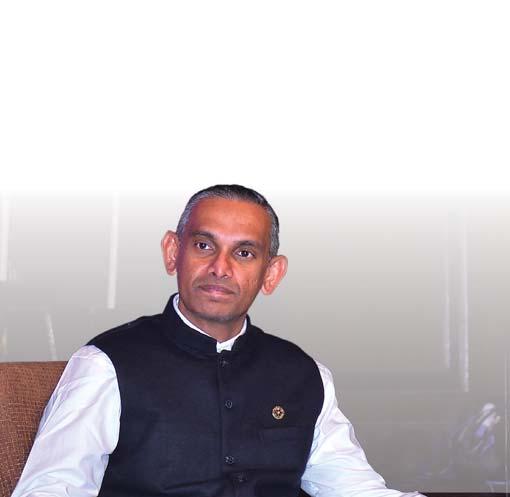

Sustain the interest of your members. Though Rotary is among
a government grant that his club worked out for up a centre in he related how the also had a simia t t h e r igh t moment. “Th ere cannot be agreement because there is no urgency to deliver.” a wit i h Dr A T Kuummar a a arraj h ah and n Me M hta.
PRID Y P Das with Dr A T Kumararajah and Nipun Mehta.
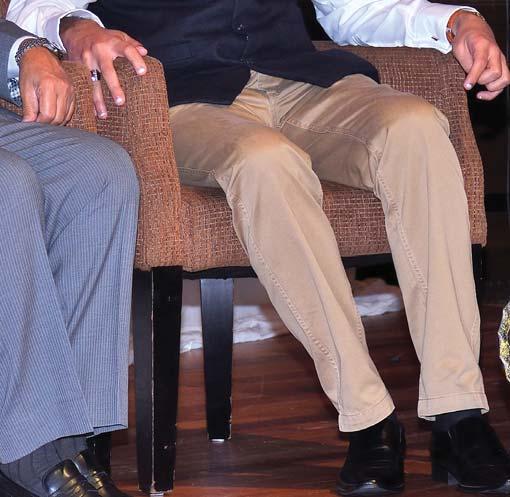

the top five service organisations, there must be some means to sustain the interest of members, some reason to tie them to the organisation. “In this new world order, one cannot expect loyalty or prestige towards a particular club. Instead, people of the millennium attach stronger ties to a concept,” concluded Kumararajah.
“My life is an attempt to bring smiles in the world and silence in my heart. I want to live simply, love purely, and give fearlessly. Service doesn’t start when you have something to give; it blossoms naturally when you have
g y you have whe n nothing left to take.”



So said Nipun Mehta, the founder of servicespace.org, a nonprofit that promotes a culture of volunteerism and generosity in a natural way. His talk was charged with stories of acts of kindness inspired from people such as Mahatma Gandhi and Mother Teresa.
‘Be selfish; be generous’ is the motto he propagated. “Your act of giving lifts up your oxytocin and serotonin levels making you feel good, apart from being beneficial to the receiver. It is impossible to give without receiving.”
He listed out the fundamental insights of giving:
Everybody is good at something Everybody can be great at giving
As giving gets connected, a gift ecology emerges — it links one by one and you start growing in generosity Everyone is connected to everything If you start putting price tags for everything, you will lose connection with the ‘priceless’.
Talking about Smile Card, he urged the delegates to try it and experience the happiness it brings. “It is a game where you sponsor another person’s meal or do any anonymous act of kindness for someone; leave a Smile Card behind to encourage them to pay-it-forward,” he explained.
“Seeing you all here, one thought comes to me: why didn’t I officially join Rotary 40 years ago? I’ve been an honorary Rotarian but that is not the same,” said Shiv Khera, before addressing the Institute on ways to win. He related how he advised his daughter, who recently relocated to Singapore, to join a Rotary club to make friends.
Some takeaways from his address:
If you are depressed, go out and help someone who needs it very badly.
Do something for others who can’t repay you and watch how your self-esteem shoots up.
Self-esteem is achieved by feeling good after doing good to others.
Confidence without humility amounts to arrogance.
While change is constant, three things remain constant: people’s skills, persuasion skills and prioritising skills.
Promise is what you make to others and commitment is what you do yourself.
He signed off with a message on the importance of time. “We often say ‘Time flies’. If time flies, time becomes an aeroplane and you are the pilot. If you can’t control it, you become the passenger.”
Pictures by Rtn Sridhar Bharathy
Ihave been to several GETS programmes but never been to a great party such as the one we had last night. We never throw parties like that, so you must be a very special group. And I am grateful to RI Director C Basker for inviting me… any opportunity to talk to incoming Governors is special,” said RI Director John Matthews, addressing a GETS session at the Kuala Lumpur Zone Institute.
At the outset, he thanked the DGEs “for stepping up and accepting the responsibilities associated with serving DGs. Without your commitment and passion, there will be no energy to drive the Rotary machine forward.” The RID made it a point to thank the spouses of the incoming governors, saying, “The service you do is very important, as you
are encouraging and supporting your partners, and standing by their side as they do various projects.”
Their training was going to get even better at the International Assembly in San Diego, “where we will be working with you on Rotary’s vision statement, which we are trying to roll out in a new format — People of Action — and you are going to create a lasting change in the globe, our communities and ourselves.”
Matthews said the most amazing aspect of leadership in Rotary at any level was that while being so busy working for the community “we never realise that the person who changes the most is you. We come to serve and help others but that is a byproduct… what really happens is an improved you, a better you.”

He said while training for their roles, they would gradually recognise that there are things “we can do to change the way we interact in our districts. IA training is going to be great, every Rotarian who has attended the IA says that was the best meeting I went to. It was more meaningful, impactful, powerful than any meeting I went to in my whole life and very special!”
In San Diego they would meet people with skills very different from what they themselves had, and they might see some of those and think “I want to be like him. But that’s a trap, because you have to keep being you.” The experience could certainly help them hone their own skills, “but if you stay true to you, trust me, you’re on the right track.”





Matthews then shared with the DGEs a valuable tip that any leader, either in Rotary, business or elsewhere, could use. “Close your eyes and think about someone in your life who was special, whom you admired… the way they communicated, their sense of humour, how they responded to bad news, didn’t yell, and handled it admirably.”
Similarly, each one of them should also do the opposite, and think of one who “took on a job and didn’t do it so well, and struggled to communicate, yelled when they got bad news, and lost their sense of humour. They weren’t bad people. They were just struggling in their jobs.”
asked by one of the incoming governors why membership was falling or static in the US, RI Director John Matthews said that the conversation around membership had to be overhauled. While asking Rotarians to give for TRF, there were always some expectation and goals being set.
new clubs nor growing themselves. We have too many clubs that are locked into the belief that I have 20 people. I like these 20 people, am comfortable with them and I don’t want to grow and have any more.”
We never realise that the person who changes the most in a Rotary leadership role is you. We come to serve and help others but that is a byproduct… what really happens is an improved and better you. what is an you


“But in membership, there is no expectation anywhere in Rotary that we not only grow but sustain that growth. We have to put that expectation before people while speaking at PETS or GETS and tell our presidents and governors that it is completely unacceptable not to grow or charter new clubs. But today that doesn’t happen.”
He suspected that many club presidents thought “somebody else will grow membership. I am comfortable here. We have to make everyone play their part. Unless we bring that upfront it will not happen.”
For the last 23 years Rotary’s global membership was at 1.2 million, but the average club size had come down in the last 10 years from 42 to 34. “What’s broken is that the existing clubs are neither chartering
That was the main problem and defied the business adage that you’re either growing or dying. “And these clubs don’t even realise that the moment they say I’m fine at 20, they are dying. Because 20 years from now, they won’t be around. The only way is to grow their club and keep growing,” added Matthews.
Another question was if the role of the DG was of leadership or administrative in nature.
“It is everything,” said Matthews, adding, “but it is how you do it. If you look at the organisation of a company, the CEO is on top, and below him/her comes the Board and then the employees, customers, etc. ” So it was a triangle.
In Rotary clubs it was the opposite. The most important person was the member, the board and the president supported the members and the DG’s role as a leader was at the bottom.
After identifying these two extremes; the DGEs should use them as their “reference points, and anything that you do from this point on, when you face a challenging situation, step back and ask yourself how would this person have handled this situation. Draw from the experience of these two leaders; and you’ll know what to do and what to avoid.”
Another valuable insight Matthews shared with the DGEs pertained to the
time when he was being promoted from a lieutenant to a lieutenant commander in the US Navy, which he has served with distinction for 20 years. “The admiral, who promoted me, put his hand on my shoulder and said: ‘John, up to this point I have been evaluating you on the work you can do. From this point onward, I will evaluate you on what you can accomplish from others.” The incoming DGs were in a similar position; having accomplished a lot; “but now as you step into the role of a Governor, you have the opportunity to
The clubs that say we are
don’t even realise that the 20, they are dying. Because 20 years from now, they won’t be around.
deal with things in a different way and through others and not necessary by what you can do yourselves.”
Other things they needed to do as district leaders were giving a direction to the club leaders, growing membership and TRF contributions, and the direction to do community projects well. All these were fine. “But the single most important thing you will do as a governor/Rotary leader is to develop the people behind you. Our business model in Rotary is based on developing the people behind us. If we ever stop doing that, the entire machine comes to a grinding halt. Does anyone know of a club that put an ad in the newspaper for the next club president? The very idea is absurd. We develop them from within as we do all our leaders.” Successful businesses did just that.
Matthews said that when Basker had urged them to ask the clubs to print newsletters, “do you think he wants you to just print some information or did he mean that through the newsletter you can teach Rotarians the magic and

wonder of Rotary? You have to tell them stories. If you simply print that newsletter you lose the opportunity. But if you use that newsletter to help people see the magic and wonder of Rotary, you are developing the people behind you.”
For eg, said the RI Director, if the Governors simply told Rotarians that TRF had a four-star rating with Charity Navigator, they would be proud of it. “But isn’t it better if while you tell them how great the Foundation is, you also explain to them what we did to get the four-star rating? Can you see the difference?”
Matthews added that as the DGEs developed leadership in others in their team, “at the end of the year you’ll be a whole lot smarter than you are today.”
The admiral, who promoted me, put his hand on my shoulder and said: ‘John, up to this point I have been evaluating you on the work you can do. From this point onward, I will evaluate you on what you can accomplish from others.

The second important message was on continuity. One of the things Rotary had struggled with over the years was continuity of leadership. “So what you see evidence of is 112 one-year plans; this has some charm because each one is unique and different but not linked to one another.”
In the last few years a strategic plan had developed; “for the first time you see Ravi (PRIP K R Ravindran) start something and John Germ continues that and they model that continuity through President Ian Riseley and RIPE Barry Rassin. And we need to model that in our districts.”
In many parts of the world there was continuity between the IPDG, DG, DGE and DGN. “So when questions come on the district, you are not alone, your team answers. In doing that you are allowing the DGE, as also the DGN, to learn what the answer might be. You are developing the people behind you. The same needed to be done at the club level, he said, adding, “by doing so you will be creating a better and more effective direction in the clubs and the district.”
Pictures by Rasheeda Bhagat
Everybody waits for October to paint everything pink. “But cancer doesn’t care what month it is. We can’t focus on cancer only in October,” says PDG Kishor Kedia, D 3030, who is the Project Coordinator of RC Amravati Midtown’s mammography van run by Panjab Rao Deshmukh Medical College. Women unable to access breast cancer screenings in rural villages of Maharashtra, now have the screening at their doorstep.
The initiative was inaugurated by former President of India Pratibha Patil at Raigad in Pune. Within the first month of hitting the road, about 3,000 rural women have been screened. The van, imported from the UK, is self-contained and in addition to the latest digital mammography equipment, has a waiting area and a private dressing room. “First aid and in special cases minor surgeries and deliveries can also be done inside the van,” he adds.
“Prevention and early detection are a woman’s best chance against cancer,” says Dr Deepali, medical head of the van that travels from village to village with the goal “to detect potential cancer risk through screening and provide important health education to rural residents.”
In order to register for a mammogram, women are informed via WhatsApp and word of mouth. In few places where connectivity is low, small nursing homes or schools are contacted to spread the message. The van is stationed at a village from 9am to 5pm and close to 100 women are screened in a day. “Most women are unaware about the test; after they are told about it, they realise this isn’t a blood test.” Some women back off at the last minute because they are shy to change their clothes in the van and are uncomfortable with the examination even though it is done by a female doctor.
If tested positive, the patients are contacted in private and referred for further treatment to the Shirdi Trust,
action action people people of
Kiran Zehra
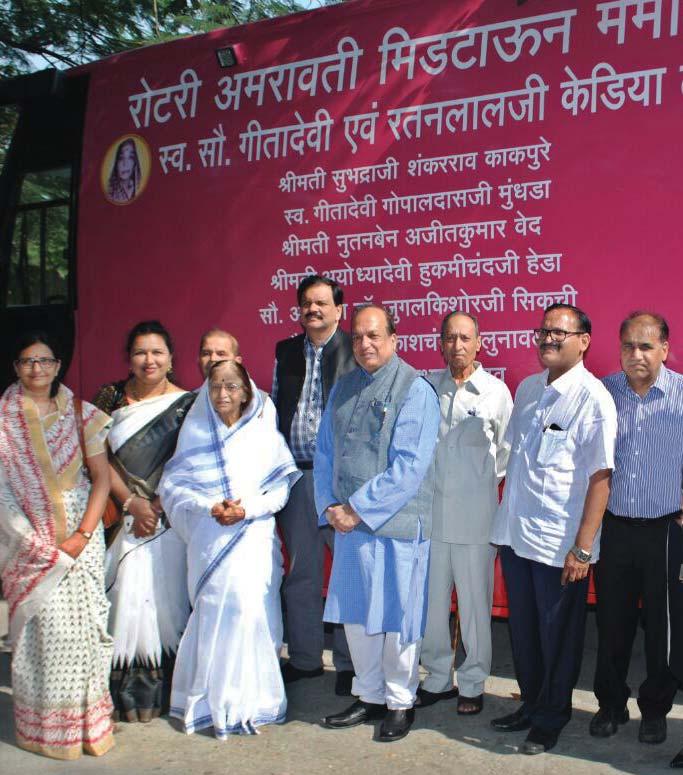
that has a tie up with the club, where treatment and surgery is performed free of cost.
As DG in 2013–14, Kedia’s goal was to undertake and complete womenrelated programmes. Apart from his personal contribution of ` 1 million, the rest of the money came from Rotarians of RC Amravati Midtown.
“We are very excited about the opportunity to bring mammography directly to rural women. No matter what their circumstances, whether it’s lack of money or proper transportation to reach the medical centres, we are trying to make sure all women in our region have access to this lifesaving screening,” he says.





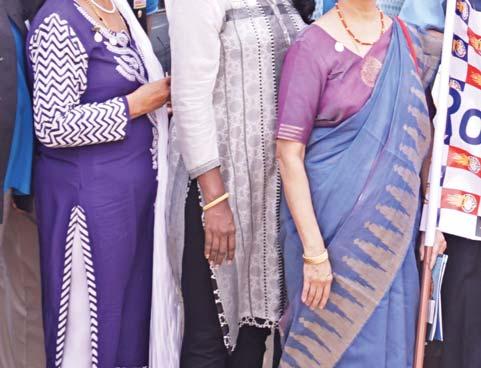


t was an awesome journey of bonding and fun. Lifelong friendship beyond boundaries and ethnicity is our cherished takeaway,” said PDG Subodh Joshi of District 3131.
He led a 30-member car rally across all the 36 districts of India covering 10,000 km through 21 days.
The journey was flagged off on Dec 10 in Pune by DG Abhay Gadgil and as the convoy passed each district, the team got a rousing reception. PRID Ashok Mahajan flagged off the rally at Mumbai, while TRF Trustee Sushil Gupta did the honours in Delhi. In Chennai, they were felicitated by PRID P T Prabhakar. At the end of the

journey on Dec 31, the team basked in a hero’s welcome in their home district in Pune and were the star attraction at the District Conference.
The message
It was basically a public image enhancing exercise; “We propagated the message: My Rotary One Rotary;




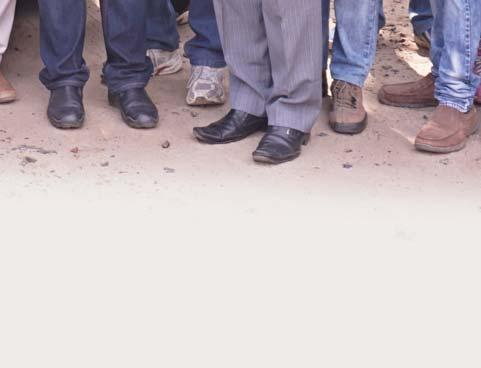


PRID P T Prabhakar and spouse Nalini, along with PDG C R Raju, flag off the rally in Chennai. DGE Babu Peram and DGN G Chandramohan (extreme left) are also seen with PDG Subodh Joshi and his team of rallyists.
it was an exhilarating experience being received and hosted with such warmth by the Rotarians and the general public in each district. We carry heartwarming memories from all the places we visited,” said Joshi.
Besides image-building, the team sensitised people on road safety, Rotary’s literacy programmes, sanitation and polio eradication initiatives.

headlight stickers on trucks and talked to drivers to stay alert while driving, to avoid accidents,” he said.

“Wherever we stopped, on wayside tea-stalls or dhabas, we put up Rotary posters. As we passed through small towns and villages, we spoke to people on importance of literacy and urged mothers to continue administering polio drops to infants. We stuck
The highlight of the programme was that each participant personally contributed `1 lakh to meet the costs. It was not a club-sponsored project.
The rallyists were from different clubs of District 3131, and included an Ann and three Annettes. Rakesh Monga, son of Kailash Monga of RC Poona, had specially flown down from England to be part of the rally.

“These 21 days have been so much fun and a great learning experience,” said

Deepti, spouse of Ajay Chitnis of RC Pune Central, while Smruti Joshi who, “loves to be behind the wheel”, said she enjoyed every moment thoroughly. Smruti is the daughter of PDG Subodh Joshi; she has participated in several rallies.
“We are an adventure-loving family,” said Joshi, who is also a mountaineer, recalling his recent trek to the Himalayas, where he led 2,000 Rotarians as part of the Walk for those who can’t initiative, a fundraiser to aid polio victims.
Most of the rallyists were meeting for the first time. “We’ve become so close. We now have friends everywhere


InChennai, the Rotary News Trust office welcomed the team, on their 16 th day of the rally.
PRID P T Prabhakar, PDG C R Raju, DGE Babu Peram, DGN G Chandramohan and Rotarians from various Rotary clubs of D 3232 were present to greet the team.
PRID Prabhakar lauded the initiative. “We’re arguably one of the biggest service organisations. Yet not many people know what we stand for. Show the Nike or Mercedes logo to a common man, and he’ll easily identify them. But
show Rotary’s wheel, not many people will be able to answer.” He commended the team for the causes they had chosen to highlight and the fact that “they spent their personal funds for promoting Rotary’s public image.” Joshi was full of praise for his batchmates of 2015–16. They helped him identify accommodation facilities for the team in each district. “In Udaipur (D 3053), we were floored by the 16-bedroom palace they had arranged for our stay. In Bikaner, PDG Arun Gupta welcomed us with 100 cars and it turned out to be a mega rally as we
It was an exhilarating experience being received and hosted with such warmth by the Rotarians and the general public in each district.

went around the city, waving the Rotary flag.” In Jodhpur, PDG Anil Beniwal gave them a grand welcome, while PDG Sattish Singhal offered them his college hostel for overnight stay at Sonepat.
Joshi is now on the job to publish a coffee table book showcasing the top 100 projects that impressed him and his team across the country. He plans to “give it to all the clubs that hosted us and also place it in libraries so that people can understand what Rotary is doing.”
from Jammu to Kanyakumari,” said an excited Joshi, relating how the Lucknow Rotarians helped speedy repair of the car of Pradeep Mulay (RC Pune Pashan), which was hit by a truck at Pathankot. The vehicle was delivered to him in Visakhapatnam within three days. When Joshi’s car was involved in a minor accident in Guntur, two local Rotarians there “scouted for a mechanic’s shop, since it was Christmas and most of the shops were closed; I was pleasantly surprised when they delivered it at 11 pm in Nellore. This is the power of Rotary fellowship and we experienced it in full force throughout our journey.”
The Rotary convoy with eight cars, adorned with various Rotary logos, attracted attention everywhere. “People stopped us at traffic junctions and toll gates to ask us about Rotary. We were interviewed on TV channels and news about the rally was published in newspapers too.” The district website updated the whereabouts of the rally team on all days.
Pictures by K Vishwanathan

Rotary Club of Berhampur, D 3262, organised a mega public awareness campaign to commemorate the World Polio Day (Oct 24), involving over 1,700 students from the city schools and colleges. The students gathered together at the Berhampur stadium to form
The event involved 1,729 students surpassing the earlier Guinness Record of 1,290 participants.

a large human image of a foot. The 132’x53’ formation was created within 34 minutes and 13 seconds, well within the 60 minutes deadline. Drones and multiple angle cameras captured the event.
Project Chairman Bijay Bagaria said the event that involved 1,729 students could surpass the earlier Guinness Record of 1,290 people. Officials from the India Book of World Records and Asia Book of World Records supervised the event and certified the new record. “We are yet to receive the official certification from the Guinness Book of World Records,” he said.
Club President Tapas Panigrahy chaired the event; District Collector Prem Chand Chaudhry was the chief guest. MP Sidhant Mohapatro, MLA Ramesh Chandra Chaupatnaik, Sub Collector Siddarth Swain, Municipal Commissioner Nikhil Pawan Kalyan, Rotaractors and other district officials witnessed the event.

Samarpan — The Rotary Foundation seminar — was organised at Alleppey by D 3211. Over 850 Rotarians including Major Donors and AKS members attended the event. It was led by the District TRF Chair K Babumon and inaugurated by Kerala’s Finance Minister T M Thomas Isaac.
DG Suresh Mathew highlighted the District’s various endeavours towards the welfare of the community. “We
are supporting the State Government’s ‘Ardram’ initiative by providing infrastructure and equipment for hospitals, having recently completed the renovation of a 4,500 sq ft women’s ward in a hospital.” The district will be building toilets in 40 schools with `1 crore grant approved from TRF and has mobilised `25 lakh for setting up a mammography unit, besides having digitalised another unit at a cost of `1.3 crore. The district
has been quite proactive in performing global grant projects and has availed TRF funds worth nearly `7 crore for various projects in the last five years, he added.
Mathew signed an MoU with Rtn Dr Sumitran of Padmati Hospitals to perform 100 heart surgeries free of cost for the needy, under the project Hridayatalam.
EMGA K P Nagesh elaborated on various aspects of TRF — the fund flow, spendable earnings
and ways to support the Foundation. Saying that only 20 per cent Rotarians and 60 per cent clubs are contributing to TRF, he called upon the delegates to rise generously to meet the goal of $2.025 billion by 2025.
Shakuntala Raha, Manager-International Fundraising, RISAO, explained the features of the new funding model, district and global grants and how the grant application from clubs are reviewed and
processed. “Sustainability is the watchword. The project has to continue beyond the years of funding and enhance goodwill and international understanding,” she said.
While DG Jawarilal Jain, D 3231, spoke on the ‘Joy of giving’, PDG Ulhas Kolhatkar, D 3142, gave an informative presentation on the ‘Foundation of life’. DRFC Chair and AKS member G A George extolled the privileges of being an AKS member and the happiness and mental satisfaction it gives.
The chief guest lauded the Rotarians for their “wide range of projects” that has “certainly given new meaning to the lives of several underprivileged families” across the State. He launched the concept of pesticide-free rice, an


initiative of the district under the name, REAP (Rotary Empowered Agricultural Product), where the district, under the chairmanship of Bijumon Kurian

and Advisor PDG K P Ramachandran Nair, will cultivate organic rice in 136 acres of land.
Two new AKS members — Sudhi Jabbar of RC Kazhakuttom and
Gangadhara Iyer, President of RC Alleppey East — were felicitated at the seminar, in addition to 43 Major Donors and some Endowment donors.

Itis harvest time and the Rotarians of RC Barabanki, D 3120, came together to celebrate Makar Sankranti with the students of Vinoba Aawasiya Balika Vidyalaya, their adopted school in Barail. “It was such a happy moment for all of us to spend the day with the girl children at the school,” said Sudhir Verma, President of RC Barabanki.
The club members gifted inner vests, stoles and floor mats and served lunch for the students at the school. Woollen garments, shawls, stoles and blankets were distributed among 400 underprivileged people at Baragaon.

Delegates and spouses of Indian DGEs at the International Assembly.


Delegates participate in the Cultural Exchange and Networking programme.

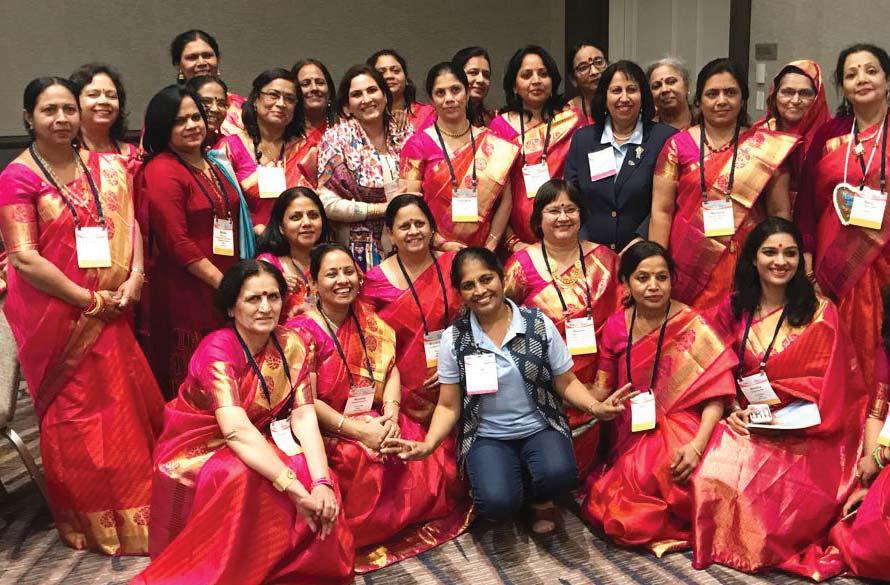









DGE
and






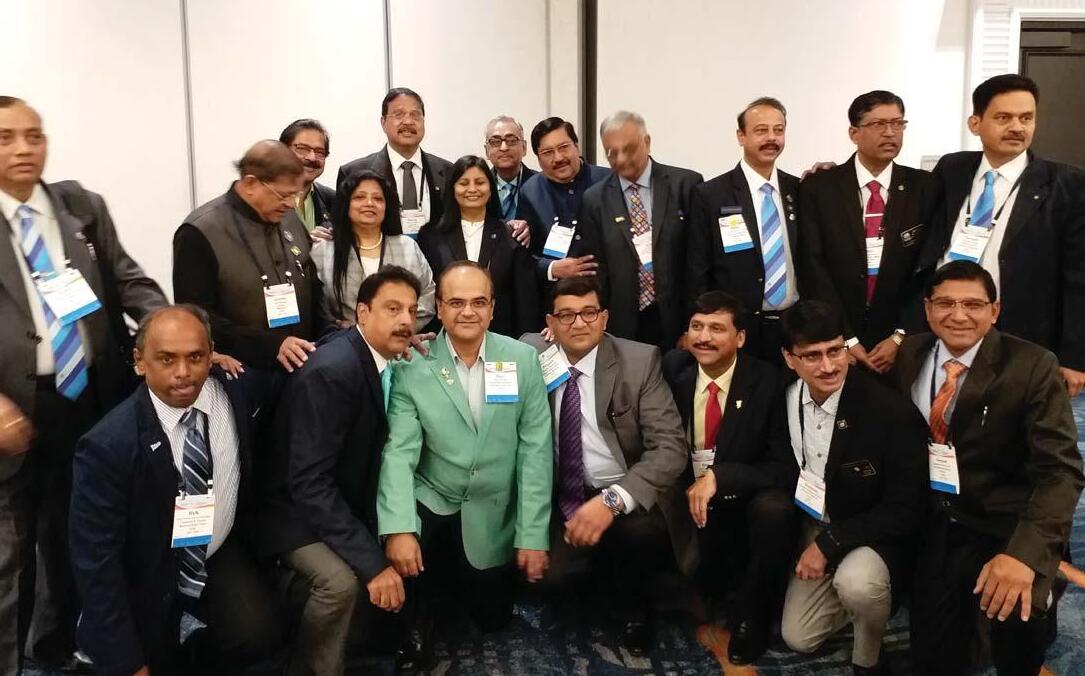
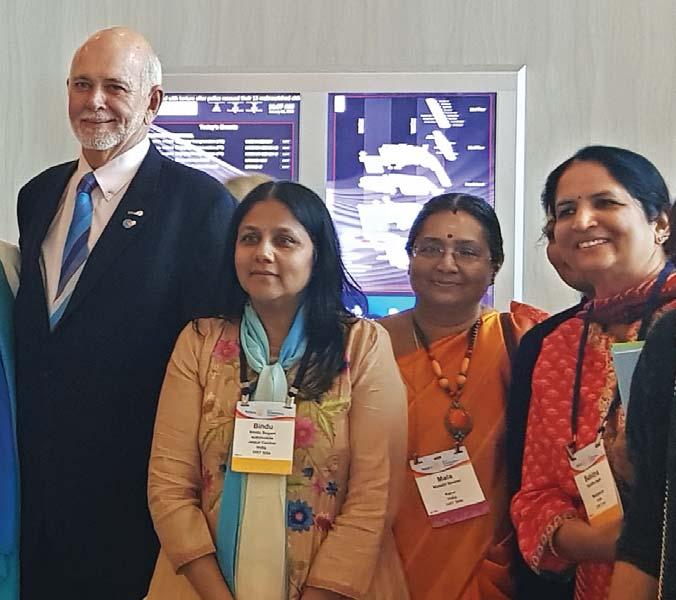




Rimika Singhvi, President of RC Jaipur Marugandha, in conversation with Rotary’s young Club President Martin Judd of RC Manchester Trailblazers.
Having turned all of 22 in April 2017, Martin William Judd is believed to be the youngest serving Rotary club president in the world and among the youngest in Rotary’s 113-year international history. Judd was born in Tokoroa, North Island in New Zealand. The son of a racehorse trainer, he grew up in Cambridge and elsewhere in the UK before moving to his present home in 2012. He then joined the newly-formed ‘Manchester Trailblazers’ Rotary Club in 2014 and
was elected President Nominee within a year.
in the Customer Services department at Manchester Piccadilly’s Waitrose branch, studying for an Open University degree in Economics and Mathematical Sciences, setting up his first company called ‘World Cultures Festival’, campaigning in local politics and — of course — leading his club!
Your motivation to join Rotary?
I was motivated to join Rotary after reading about all the fantastic projects that Rotarians have done all around the world. I also have a personal ambition to help people escape poverty and see Rotary as a vehicle to do that.

Below are snippets from a conversation I had with Judd when I happened to be in Manchester briefly during my recent visit to London. Attendance at such meetings forms part of a President’s official presence at club activities globally and are considered significant in taking up Rotary’s goals for the purpose of joint action worldwide.
Rotary plans for this year
As a club, we have set ourselves a few targets:
To boost our membership
J udd currentl y lives in Oldham, sp li tt i n g hi s t i me b etween wor ki n g e nce at c l u b act i v i t i es gl o b a ll y an d a re considered si g nificant in takin g j o i nt act i on wor ld w id e

To raise £2,000 for The Rotary
To raise £2,000 for The Foundation
To raise a total of £2,000 for other groups


The upside is people want to hear what you have to say. So new ideas can spread quickly and help change the way we do Rotary for the better.


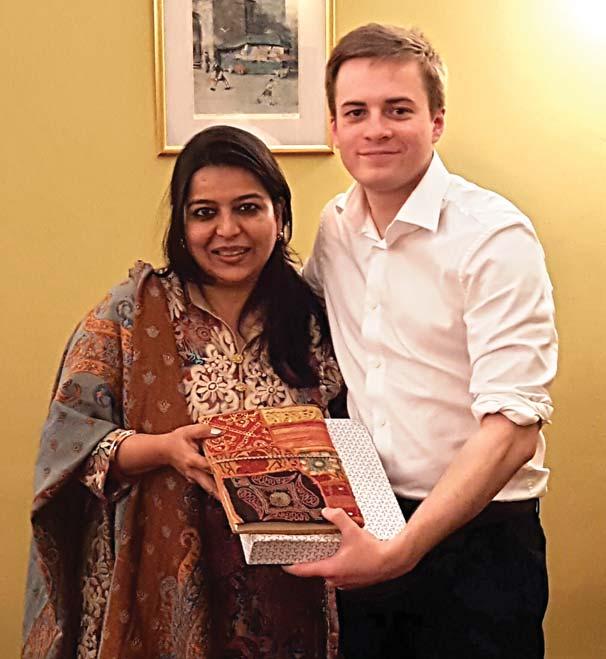
To support three local charities and an international one We are making quick progress on this and will definitely achieve it.
Your club’s signature projects
Currently, our only project is WOW Water, a water project for building pipelines in four villages in Ghana, to connect them to the main water supply. We are currently developing a literacy project for local schools as well.
Any other priority areas?
My other priority is to help grow Rotaract clubs. Presently, we do not have a Rotaract club but I would love to create one soon. Rotaract is very weak in the UK and needs a big drive to help create more clubs.
Can we work together?
I am sure there is something we can do to collaborate, maybe you have Rotaract in your area and could share some tips on how to get them started.
The ups and downs of being a young president
The main upside is that people want to hear what you have to say which means that some new ideas can spread quickly and help change the way we do Rotary for the better. It is also a fantastic experience in managing people and a good way to grow my skills.
The downside is that some equate age with capability, and believe that young people are incapable of holding high positions, but I am determined to prove them wrong by leading the club successfully this year!
Your message for today’s youth
Get out there and try your hand at something new. If you have grand ideas for change, then let them be known. Tell people about them and do your best to try turning them into reality. Be a person of action; create the change that you want to see.

action people people of
Rasheeda Bhagat
On December 19, the Zilla Parishad (ZP) school in Galandwadi, about 20 km from Pune, resembled a carnival spot. From this and other neighbouring ZP schools, 108 girls, dressed neatly and colourfully in their olive green and pink uniforms — skirts-blouses and salwar suits — had assembled. Along with their teachers and parents they had all come, armed with excitement and expectation.

It was with discernible emotion and happiness the girls received a very visible symbol of their empowerment — a gleaming new bright pink cycle. A vehicle they could call their own, and one on which they could travel to their schools without any fuss or hardship. “The joy of getting a mode of transport, confidence, gratitude… so many emotions could be seen on the faces of these girls who got the bicycles,” says Vrinda Walimbe,
President of the Rotary Club of Pune Shivajinagar, which has undertaken this project.
It all began with a past president of the club Nitin Abhyankar wanting to do something for the region his ancestors hailed from. So the club started doing welfare activities in this area right from 2010. The bicycle project was started two years ago with just nine bicycles and “now we have crossed the 500 mark,” beams Vrinda.
She says since the programme has started, the teachers at the school have seen a significant improvement in the attendance of girls. A conscious decision was taken to keep the colour of the bicycle bright pink “so that others in the community and the girls’ families would be deterred from using or stealing these bikes. The communities are aware that the bikes are only to be used for school purposes by the girls,

and not on the farm or around the village for chores.”
The club wanted to focus on the empowerment of the girl child in rural areas, “as we know that in rural areas in India, particularly Maharashtra, there is little or no public transport. Students sometimes have to travel on foot for more than five km to reach school.” This makes it that much more difficult for girl students to attend school regularly. “It is cumbersome
and risky to walk for hours through deserted fields to school in the early hours as well as after dusk, and in the rainy season and winters it is even more difficult,” she adds.
They found that sometimes only two girls from a locality go to school and if one of them can’t attend school for some reason, the other is forced to sit at home too, as it is unsafe for a young girl to walk a long distance all by herself. “During the difficult days of the month, it becomes physically tiresome and on some other days there is a safety hazard. All this was contributing to girls dropping out of schools in rural areas.”
So it was decided to start the bicycle project, and this got a shot in the arm when Vandana Naik, a member of the Rotary Club of Norman, USA, wellknown to one of the club members and “with whom we have been doing some global grant projects in the last
few years”, came to know about the project. When she was visiting Pune six months ago, for another global grant project on waste management training, “we took her to this school, and she was very impressed,” says Vrinda.
She works with the NGO Unforgotten Funds, and promised to raise money to buy more cycles through crowd funding. A campaign was started on their website and enough money was raised to donate 100 bicycles. The club raised some more money and a total of 108 gleaming new pink bicycles were presented to the girls from many ZP schools in the region. Right at the outset the club members decided not to give used cycles to the girls as new cycles would give them a better sense of ownership. The criteria for selecting the girls is the distance between the school and their homes, as well as the financial status of the family. This data is provided by the teachers and the
bicycle is presented with the clear understanding that if the girl leaves school for any reason it has to be passed to another student. The cycle is school property.
The club members feel the need for bicycles for girls in this region is huge and RC Pune Shivajinagar wants to provide at least 1,000 cycles to girls in the rural areas around Pune. Each cycle costs ` 4,500, “which is less than $75.
Abhyankar says that the club has been working with these school for a few years, giving them school infrastructure such as school buildings, toilets, e-learning kits, benches, etc. The next project of RC Pune Shivajinagar is to make ZP schools paper-free by giving them tablets. This will be done through
a global grant project for $34,000 which is under approval. Under this the plan is to give 80 tablets to the higher secondary schools. The suppliers have undertaken training of teachers in using these tablets and the teachers in turn will train the students.
Vrinda and Abhyankar give a major portion of the credit for the

success of this project to the teachers “who are so interested in the students’ welfare and so co-operative and dedicated that the work we have done has really had some impact. Their feedback is that thanks to the daily cycling the girls’ fitness and energy levels have improved, and the time they save through this quicker commute, is now used to complete their assignments in time and get better marks,” adds Vrinda.
Coming to sustainability, the leadership in the club is working together over the last few years to ensure this.
“I am continuing the work of my predecessor and the next two presidents will do the same. We want to serve as many schools in these villages as we can,” she adds.
Designed by N Krishnamurthy


Aseminar on TB-free India was organised by RC Nagpur Fort, D 3030, in partnership with Rotary India National TB Control and Awareness Committee and the UNION, an international forum against tuberculosis and lung disease.
The Committee Chair and PRID Y P Das was the chief guest at the event which was initiated by DG Dr K S
Rajan. The UNION’s technical advisor Shiv Shreshtha held an interactive session with the audience on the preventive measures to control the spread of TB. In his address, Das lauded the efforts of the DG in organising the seminar which, he noted, will create awareness and also usher in the much-needed behaviour changes in the society. The ways and means of Rotary’s involvement in eradicating TB were also discussed.
“The main purpose of the seminar was to sensitise Rotarians and TB officials at the Directorate of Health Services of the Maharashtra Government,” said DG Rajan. RC Nagpur Fort President Captain Milind Hastak gave the welcome address, while PP Srihari Chava anchored the seminar. The President-elect Dr Pravin Dahake proposed the vote of thanks.

V Muthukumaran

The stone chariot, also known as Garuda mandapa, was built during the reign of Krishnadevaraya in 1513 CE after the victory in Kalinga war.

Any amount of reading, browsing the internet or mining the social media will not prepare you for the cultural grandeur at Hampi, the capital of the mighty Vijayanagara Empire. It is now a village of magnificent ruins, thousands of giant boulders, caves and heritage structures that beckon globetrotters who are left breathless at the ghost remains of a once-prosperous kingdom.

Located in east-central Karnataka, the City of Victory (‘Vijayanagara’ in Sanskrit) is 12 km from Hospet and sprawled along the Tungabhadra River.
Hampi was a bustling, pilgrimage town even before the arrival of

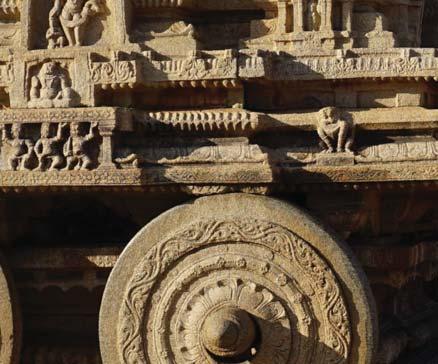





Vijayanagara dynasties who chose to make this prosperous centre as their capital. The Virupaksha temple with Lord Shiva as the presiding deity was built by King Pulakesi-II of Badami Chalukyas in the 7th century and later, was expanded by successive kingdoms. With a 52 metre-tall gopuram, the Shiva temple attracts thousands of devotees from far and wide, especially to witness the three-times-a-day poojas and abhishekam at the main sanctum. It is also known as Dakshina Kasi among the devout.

A first-timer should look out for the colourful murals and frescoes depicting the episodes of Ramayana on the ceiling of the ornate mandapam leading to the main sanctum. We are surprised by the large gathering of people, mostly women, sitting across the floor reciting mantras facing the Shiva Linga. “It is rahu kaala pooja and an auspicious time to propitiate Shiva,”



quips our guide Ravi Kumar, giving us invaluable insights as we explored the Hampi ruins.
At this venue, clusters of human settlements around temples are common and is in vogue even today. Thus, we have Virupaksha bazaar (market) on either side in front of the gopuram with people around the area using the retail outlets to sell their wares and thingamies. To be precise, the bazaar in front of Shiva temple is 740-metre-long and 45-metre in width leading up to utsava mandapa followed by a Nandi mandapa which has a 3-metre-tall unfinished Nandi (divine cow) carved out of a monolithic stone in 16th century.
Likewise, we notice Krishna bazaar (500 metre-long); Achuta bazaar (360 m); Vitthala bazaar (945 m); and Hazararamapura bazaar in front of their respective temples having just skeletons of their once



Hampi, then known as Vijayanagara, was the second richest city in the world after Vatican. Compared to its glorious past, modern Hampi is just 25 sq km.
robust structures which facilitated commerce with foreign traders. “Traders from Persia, Portugal and other European countries vied with one another to buy gold and precious gems from the Vijayanagara markets,” says our guide.
While the Vijayanagara Empire (1336–1565 CE) reigned like a supreme colossus spread over four dynasties for 229 years, the golden era was during the period of King Krishnadevaraya (1509–29) who was very popular and had a charismatic appeal over his subjects. In his regime, the empire extended from Kalinga in the East to Kanyakumari in the South comprising the entire peninsular India plus the Deccan plateau with the oceans forming the natural borders at the two lateral extremities.
Hampi, then known as Vijayanagara, was the second richest city in the world after Vatican (15th century) and according to historians, spread over 650 sq km with a population of 5 lakh by 1500 CE, second only to Beijing.
Compared to its glorious past, modern Hampi is just 25 sq km (may be lesser) comprising towering boulders, hillocks and surrealistic ruins. Here is a montage of unique sights one should not miss out at this heritage village:
Kadalekalu Ganesha temple: A 4.5-metre-tall tusker god cut out of a monolithic rock, so called
because of its appearance like an unsplit Bengal gram. The Lord carries a tusk, goad, noose and a bowl of sweetmeats in each of his four arms. This was built in 15th century.
Sasuvekalu Ganesha: This 2.4-metre-tall deity was carved in 1506 CE and resembles a mustard seed. It was earlier called Siddhi Vinayaka and is now enshrined in an open pavilion.
Hemakuta group of temples: A series of 33 shrines and mandapas built intermittently between 9th and 14th century, that means it predated the Vijayanagara empire.
Balakrishna temple: Constructed by Krishnadevaraya in 1513 CE after the victory in Kalinga war in the previous year. The defaced statue of Lord Krishna is now in Egmore Archaeological Museum in Chennai.
Lakshmi Narasimha temple: One of the finest examples of Vijayanagara sculpture, the Lord is 6.7-metre-tall and seated on the giant coils of Adishesha, the


guardian snake of Vishnu. The seven hoods act as a canopy arched by a lion’s face on the top. The four arms of Vishnu and the seated figure of Goddess Lakshmi on His lap are missing, mostly destroyed by the Sultanate invaders.
The giant statue was consecrated by the head priest Krishnabhatta on the instruction of Krishnadevaraya in 1528 CE. Badavilinga temple: A 3-metretall Shiva Linga carved out of a single rock and the legend says it was commissioned by a poor woman (“badari” in Kannada).
A hill valley of Pampa Devi
The rocky hills — Hemakuta, Mathanga, Gandha Madhava, Rushimukha, Anjanadhri, Malyavantha and Jambunatha, to name a few — offer a panoramic view of the valley from the top that delights backpackers and tourists. Hampi was a Pampa Kshetra (holy place) in Krita yuga; Kishkinta in the Treta yuga (during Ramayana); Bhaskara Kshetra in Dwapara yuga
Best time to visit Winter: November to January.
How to reach
Get down at Hospet Railway station and hire a cab. Hampi is 12 km from Hospet.
(Mahabharata); and Vijayanagara during Kali yuga. “The place got its name Hampi after the advent of the British Raj. Goddess Parvathi, also known as Pampa, meditated on the Hemakuta hill on the banks of Tungabhadra river to win the trust of Lord Shiva and over the years, ‘Pampa’ was malapropped into ‘Hampi’ with the influence of Kannada,” explains Ravi Kumar. After we’ve examined the heritage structures at close quarters, the guide reminds us that the best spectacle is yet to come, for which we have to travel by a cab. Welcome to Royal City to the southern side

Devotees chant mantras at the Virupaksha temple.
of Tungabhadra river. A jig-saw of byzantine enclosures comprising the Royal Residency (of the king, queen, inner circle), noblemen’s quarters (17 living blocks), Army chief’s enclave (Dandanayakka Enclosure); and Mahanavami Dibba (a giant pyramidal platform) make us wonder at the excruciating details and precision with which the Royal City was planned.
Here is a peek into some of the heritage wonders:
Anthapura Enclosure also known as zanana (women) quarters has two wooden storied palaces and a summer retreat in Lotus Mahal. We have to pass through the palaces of Vira Harihara and Krishnadevaraya (Ranga Mahal) to reach Lotus Mahal. The grand edifice has pillars, arches made of Islamic style, while the towers and shikaras are built in Jain architecture.
The elephant stable, a domed and rectangular structure and god’s quarters point to the lavish style of the royalty.


Royal Enclosure is the vast administrative office of the empire housing the elaborate Durbar Hall erected by 100 wooden pillars. Spread over 59,000 sq m, this complex is the nucleus of the capital with 43 buildings and protected by lofty double walls.
The Archaeological Survey had excavated a number of buried structures in this complex with their pathbreaking work from 1976 to 1986. The underground chamber for secret conclaves, 23 water tanks including the main pushkarani (sacred tank) were all unearthed by the ASI teams in early 1980s.
A beautiful pushkarani was discovered in 1986 following the lead given by the stone aqueduct
which supplied water to the Royal City through the simple force of gravity. Made of basalt stones, the stepped well is designed as a pyramid.
A public bathing pool (5-metre deep, 77-metre long and 27-metre in width) is so huge that it could easily be double the size of Olympic pool and was patronised by the common man during the empire’s reign.
Mahanavami Dibba located to the northeast of the Royal Enclosure is a terraced platform of 35 sq m for the royalty to view cultural processions and religious celebrations like Dussehra. Each tier of the platform has sculpted mouldings in the Vijayanagara style. The three-tiered stone



pyramid rises to a height of 8 metres.
The Queen’s Bath built in IndoIslamic style has an 8-feet-deep pool in a 15x15 metre water area where the queen and her maids used to have fun time.
temple
A showcase temple for the Vijayanagara style of art and architecture. It was built by Devaraya II (1422–1446 CE) and later on, the major portions were added during the reign of Krishnadevaraya.
There are five major mandapas, of which Natya mandapa consisting of 56 musical pillars and Garuda mandapa, a stone chariot with garuda in human form, attract inquisitive tourists.
The main structure has five chambers leading to the sanctum that
The Lotus Mahal holds concealed ducts to keep the room temperature cool.

holds two empty pedestals for deities, Lord Vitthala and Rukmini Devi.
Well-hatched conspiracy
In coordinated moves, the five Bahmani Sultanates attacked Vijayanagara in the Talikote War (1565 CE) in which Alia Ramaraya, the minister who ruled the kingdom on behalf of King Sadashiva (1542–70), was killed. Hearing the impending defeat, the king vacated Hampi with royal treasures including 550 elephants, 1,000 horses and other priceless wealth.
Sadashiva retreated to Penagonda in Anantapur which saw the birth of Araveedu dynasty, the last of the four Vijayanagara lineages. “But the Sultanate invaders looted, plundered and burnt the capital for six months, after which it was abandoned and turned into a ghost city, a no-man’s

land,” says Rtn Muni Vasudeva Reddy, President-elect, RC Hospet.
Hampi today
Only after the village got its UNESCO heritage tag in 1986, it gained visibility among foreign tourists. “But the State government has to take up marketing in an aggressive manner for tourism is the only income earner for the locals,” says Ravi Kumar. With a dwindling population (less than 10,000) and strict regulations by the ASI, the youth here have only two options — either be a tourist guide or drive autos to make a living, but they are not assured of a regular income as tourist flow is seasonal.
Pictures by V Muthukumaran
Designed by Krishnapratheesh S

Rotary Club of Madras, D 3232, hosted the Rotary International Cup recently at the Madras Race Club (MRC). “It was our way of thanking our members for the good work they are doing for society — right from eradicating polio to enhancing people’s lives through better health and literacy,” said PDG R Ramakrishnan, the Chairman of MRC, adding that for many Rotarians it was a first visit to the vast grounds and grand ambience of MRC.
Ramakrishnan is chairing the MRC for the second tenure after 1980–84. An avid follower of the races, he is a steward since 1972 — “the second longest serving steward”. He became a member of RC Madras in the same year and served as governor of the undivided RI district 323 in 1992–93.
The event was designed to promote Rotary’s public image. “We used to sponsor the Cup in the earlier years. I am happy that this has been revived,” said PDG P T Ramkumar, also a member of the MRC’s management committee. He recalled the warmth shared by his father, Ramakrishnan and Apollo Chairman Dr P C Reddy. “I used to book their train tickets to Bengaluru for the races in those days,” he said.
Dr Reddy, the founder-chairman of Apollo Hospitals, is also a member of the MRC committee and a regular at the races. Shifting focus to India’s health status, Dr Reddy said that he was worried about the heart problems faced by today’s youngsters. Thanks to the complications caused by heart problems among young Indians, their life span has come down alarmingly.
India is losing 600 people daily due to heart diseases, he said and added that people’s mindset needs to be addressed. “They are reluctant to undergo a test, simply because they are scared that the doctor may find out something. People don’t understand that we are there to help, and the sooner the diagnosis, the better.”
Reddy was appreciative of the efforts of corporates such as TCS and Cognizant in providing cardiac health camps across the country.
PRID P T Prabhakar, who was present at the event, was quick to extend Rotary’s support, asking him to suggest where and how Rotary can help. He also highlighted Rotary’s reach in the eradication of polio. “I’m aware of the great work you are doing and I will be very happy to work with you,” said Dr Reddy.

V Muthukumaran

The Government Girls High School at Mogappair East, which is adopted by RC Chennai Mid City, D 3232, has now been given a spanking new 200-metre athletic track. Once a school with a dilapidated building, the campus now has a neatly laid-out playground, four toilet blocks, a feeder school, a new kitchen for mid-day meals, an indoor games arena, an e-learning lab, a well-stocked library and purified drinking water.
Under the Empowering Girl Child Mission, the club first built a toilet (2007–08), and later after an MoU with the State government added more facilities to make it a model school.
Slowly the academic performance improved, the old building was replaced by a new Rotary block at a cost of
`1.4 crore, which was inaugurated in December 2016, said past president and Chair of the Mogappair School Task Force L Ashok. “The objective is to do ‘intensive community service’ by providing all facilities including sports infrastructure and also take care of their maintenance,” informs S Muzhumathi, Rotary Coordinator and a teacher.
The school has now applied for an upgrade into a higher secondary school, up to Class 12 and proposes to double the number of girls to 800.
To make quality education affordable to the poor children, the Anns of the club will form a committee along with the teachers to ensure the school is properly managed and maintained.
District basketball champion S Shembaruthi (Class 9) and her friend V Gangadevi are elated that they can
now improve their game with the addition of this new sport facility.
At the inauguration of the athletic track, DG R Srinivasan complimented the club and the teachers for their “dedication and enthusiasm”, adding that though RC Chennai Mid City “keeps a low profile, they do excellent projects like this one.”
Legislator V Alexander who inaugurated the track lauded the Rotarians for their humanitarian projects.
Club President Deepak Rajendran said so far `2.5 crore has been spent on the school, and all the money was raised through donations and leveraging the contacts of the club members.
Eppendorf India has funded the construction of the athletic track which cost `19 lakh.
Picture by V Muthukumaran

WhenMaheswari (20), a polio victim, requested SSK Thiagarajan, a past president of Rotary Club of Dharapuram, D 3202, to help her in some way, little did she realise that she will get a brand-new Scooty, to ease her commute between home and her workplace.
The Rotarian sponsored the two-wheeler, specially customising it to support her disability, and presented it to her in the presence of the District Governor P M Sivashankaran, on the World Polio Day.
Maheswari works in a Xerox shop in Dharapuram and is happy and full of praise for Rotary to have gifted her the vehicle that will make her commute far easier and comfortable.
“And a big thank you to Rotary for its dedicated efforts in eradicating polio from our country. It is heartening to realise that no more children will be paralysed by this killer

virus,” she added, with a teary smile. The day was also commemorated with a rally organised by the club to create awareness about Rotary’s efforts in polio eradication and sensitising people to keep their surrounding clean and free of garbage.
The club is working earnestly on educating

school students about basic hygiene and sanitation. Energised by the loads of ‘thank you’ and cheery smiles from students and teachers at N Chinnaswamy Pillai Municipality HS School for the installation of handwashing station on the premises, Club President S Easwaran is buoyed up to take up the WinS project to more government schools. “It cost us around `60,000; we are happy that nearly 500 students are now regularly using the facility and work is underway in four more panchayat schools to provide similar facilities,” he said.
P S Saravana Subbiah, a Rotarian from Erode, provides the handwash facility at a concessional
rate of `10,000 a unit. The Rotarians impart awareness on handwash and personal hygiene to students at regular intervals. “So far, nearly 850 students from 15 schools have benefitted from our WinS programme,” said Easwaran.
The Club Secretary M Kalidas listed out few other projects being done by the club. These include a play zone costing ` 50,000 set up in a residential locality; regular visit to an old age home, cheering the senior citizens there with utility kits, gifts and nutritious food; and providing stationery materials, school bags and lunch boxes to schoolchildren.
Some important information, deadline details and other news updates from RI South Asia Office:
Clubs in Zone 4 and 6A need to complete E-Voting for Director-nominee election on or before Mar 1, 2018. E-Voting links have already been sent to respective club presidents on their registered email IDs. In case of any queries, please write to corporate.governance@rotary.org
Club invoices for January 2018 are now available on the RI website www.rotary.org. To view your club’s invoice, sign-in through ‘My Rotary’ – click ‘Manage’ –click ‘Club Administration’ under ‘Club & District Administration’. Amount to be paid is mentioned under ‘Payment Due upon Receipt’. For clarifications, please contact Nidhi Khanna at Nidhi. Khanna@rotary.org
Clubs which were terminated due to non-payment of July 2017 club dues are encouraged to fulfill the following compliances for reinstatement within 150 days from the date of termination:
Pay all outstanding financial obligations at the time of termination.
Pay all membership dues that continue to accrue thereafter.
Pay a $30 per member reinstatement fee plus GST @18%
Reinstatement application.
Please note clubs stand permanently terminated and cannot be reinstated after 150 days from the termination date.
Indian donors who want to avail benefits under Section 80G of the Income Tax Act are requested
to contribute before March 31, 2018. Rupee-enabled online giving is available on both Rotary Foundation (India) [RF(I)] website www.rotaryfoundationindia.org and Rotary International website www.rotary.org.
Attention to approaching deadlines:
Clubs are requested to report incoming club officers online by Feb 28, 2018 so that their names can be included in the RI’s Official Directory for 2018–19. For any club data related communication, please write to data@rotary.org Deadline for pre- registration discount for the Rotary International Convention is fast approaching. To avail a $10 discount, please register online on or before Mar 31, 2018 at http://www.riconvention.org/en/ toronto/register
Here are two books on Rotary authored by two Rotarians of District 3211.
Know your Rotary written by N Baskaran Pillai is a ready reckoner with detailed information on all Rotary aspects ranging from how it was started, themes of various leaders, RYLA, conventions, awards, COL, TRF and more. The book has been lauded by PRIP Rajendra K Saboo; “… this book is not an ordinary Rotary information publication; it is a product of commitment to Rotary and labour of love. The book is an excellent reference material for any student/practioner of Rotary,” he has written in his foreword.

Price: `399. Email: bhaskaranpillain@gmail.com; Mobile: 9847157170.
Rotary Protocol and Decorum written by Tomi Eapen, past president of RC Alleppey and Chairman of the District Protocol Committee, highlights the essential protocols to be maintained in Rotary meetings, a knowledge of which will help avoid embarrassments, while enhancing the dignity of the club. The booklet also has some of the points translated in Malayalam. It’s a book of “excessive thoroughness, born of experience and worth passing on” comments P O Thomas of RC Alleppey.
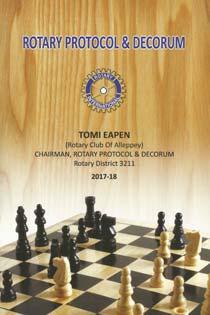
Price: `50. Email: tomieapen@yahoo.com Mobile: 9447799689
Rotary District 3250 celebrated their District Conference, Sitarey, at Delhi in the presence of RI Director C Basker, his spouse Mala and TRF Trustee Sushil Gupta. PDG J B Kamdar was the RI President’s Representative. Over 1,200 delegates attended the event.
Three service projects that included setting up an advanced cancer diagnostic centre in Patna, a retinopathy centre in Muzaffarpur and a dialysis centre in Kodarma were launched during the conference. “We
are doing these projects with global grants,” said DG Vivek Kumar, adding that the retinopathy centre will specially help treat premature babies born with retinal disorders and it will serve as a referral hospital to six Rotary eye hospitals in Bihar.
Director Basker appreciated the district Rotarians for the initiative.
The district also contributed `1 lakh to RC Pilkhuwa, D 3012, for setting up the Rotary Bhawan and Pathology Centre in Pilkhuwa, UP.

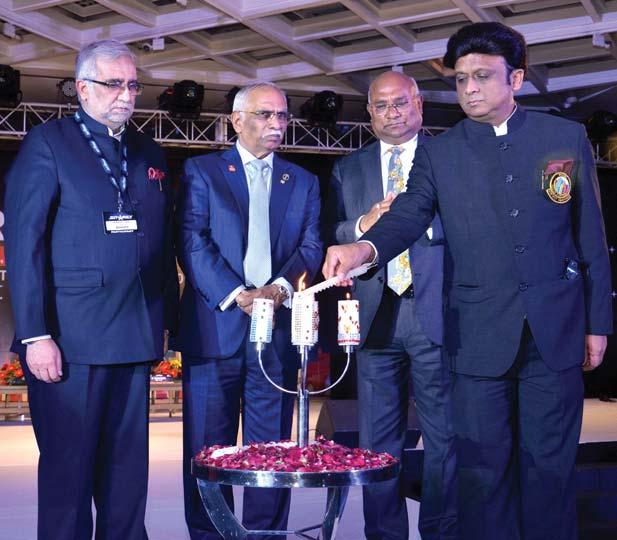
of
Speakers such as Shiv Khera, Magsaysay awardee Shanta Sinha, spiritual guru Rishi Nityapragya inspired the audience with interesting talk. Mitty Chang, Member — RI’s Rotaract-Interact Committee and IPP of Rotary E-club of Silicon Valley, D 5170, spoke about how his involvement with Rotary has shaped his personal growth. He has transitioned from being an Interactor in 2005, a pro-active Rotaractor in 2007 and to eventually charter his club in 2016.
“It was a wholesome event and I felt happy when Trustee Gupta commented that he was surprised to see a full audience even on the last day. Such meetings are platforms which will encourage better bonding and motivate us to reach for the stars,” said Vivek Kumar, summing up the success of the conference.
Remember those childhood days when we would feel all excited on the first day after a long summer vacation to see our school, freshly painted, blackboards spruced up, library stocked up with new books and new play equipment added.
A school should look inviting and warm enough to ignite interest in children to step in and, more importantly, sustain their interest to pursue education, says Amit Marodia, President of RC Siliguri Central, D 3240.
Moradia was instrumental in the club’s recent success in bringing to life the Buddha Bharti Bhuban Mohan Vidyamandir, a government school in Siliguri, that was in a bad shape.
“Every morning, on my way to office, as I pass by this school, I would be struck by its pitiful sight, until one fine day, along with Club Secretary Prem Agarwal and Community Service Chair Bikash Agarwal, I met the principal with an offer to help.”

The school has a strength of just 50 students, three of them differently-abled, and six teachers. Its walls were shorn of paint, the compound walls down, and wild weeds growing all over the place.
The school principal was too happy to cooperate and coordinated with the relevant authorities — the Chairman of Primary Schools Pradeep Bhattacharya and Ward Councillor Kamal Agarwal. The Rotarians formed a committee with
club members Pankaj Agarwal, Ajay Goyal, Gopal Agarwal, Pawan Agarwal, Ghanshyam and Deepak Agarwal, and began the renovation work in the first week of October after complying with the necessary formalities.
Soon the school donned a new look with a freshly erected compound wall, the whole building painted in bright blue, flooring redone, library refurbished with books, classrooms done up with green boards,

Before and after: The now vibrant looking school, and (on the right), the pathetic state it was in.



Students absorbed in an art competition organised by the Rotarians.

colourful charts and new benches and desks for children. The playground was cleared off the wild growth, new play equipment were added and two toilets and handwash stations constructed with
adequate water facility. The Rotarians set up a computer lab to help the children with digital literacy. The renovation cost of `5 lakh was pitched in by the members and from the club fund.
The school is already receiving enquiries for admission for the next academic year, whereas earlier, getting students was a huge challenge.

The new school was officially inaugurated by the ward councillor on Nov 12; “this was our Children’s Day gift for the students. The excitement and the look of awe in each of their faces is something to be cherished,” says Marodia. It has become “visible at last” as he learnt from the principal that the management is already receiving enquiries for admission for the next academic year, whereas earlier, getting students was a huge challenge.
Kiran Zehra
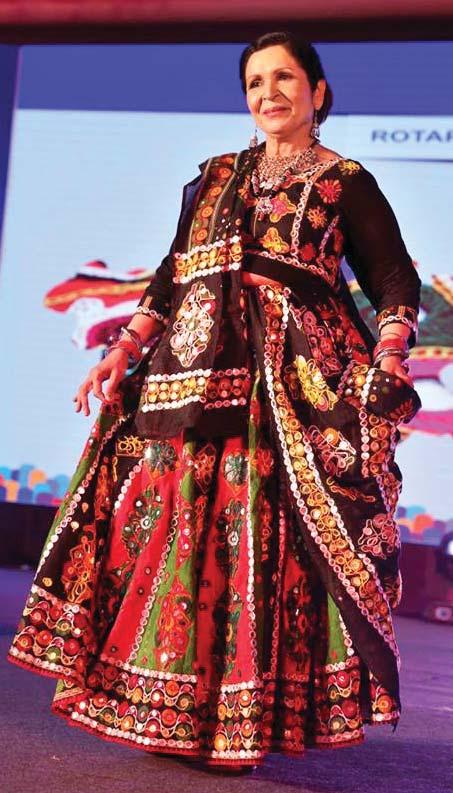
RID C Basker, TRF Trustee Sushil Gupta and DG Ravi Choudhary with participants of the ramp walk.


Rotarians of D 3011 payed a fitting homage to the indigenous culture of Indian handlooms while adding glitz and glamour to the Annual Rotary District Foundation Ball. Dubbed as Tana – Bana, a cultural extravaganza organised by DG Ravi Choudhary and spouse Ritu in Gurugram, the event supported and promoted various Indian handlooms and its weavers.
The first Rotary Ball was organised by PDG Roopak Jain during his year as Governor (1996–97).
Highlighting the weaves from various States, the presidents, assistant governors and their spouses walked the ramp and presented a spectacular show. Talking about the ramp show DG Choudhary said “Rotarians and their spouses did a fantastic job in highlighting the core essence of traditional Indian textiles and their age-old legacy.”
This industry, besides showcasing the country’s impeccable skills and expertise to the world, is the second largest employment provider for rural India, after agriculture. Handlooms have a low carbon footprint, as they consume less infrastructure, power and other mechanical tools. “The entire business of fashion and fabrics revolves around the artisans and weavers. It is sad that the weaver community is fading. The need of the hour


Handlooms have a low carbon footprint, as they consume less infrastructure, power and other mechanical tools.
is to spread awareness and preserve the art form which may otherwise vanish without our support,” said Choudhary.
The show received appreciation for its concept, choreography and presentation. Emphasising the need to showcase the weaves of India, eminent Rotary leaders RID C Basker and TRF Trustee Sushil Gupta requested the DG to repeat the show at the next Zone Institute to be held in Chennai.
Pointing out that there’s hardly any need for one to glamourise Indian handlooms, the DG said, “It is sad that we have to promote the original richness of our own textiles. Our handloom industry needs our support and as Indian Rotarians, let’s do our bit.”
Khadi, mangalgiri cotton, tussar silk, ikkat, patola, kutchi embroidery, phulkari, paithani brocade, mekhela chador and muga silk were few of the handlooms showcased at the event.



Conflict is the theme of two short novels — one about Sri Lanka and the other about Vietnam


I-
A Long Watch: War, Captivity and Return in Sri Lanka
The Sorrow of War






Sorrow of War



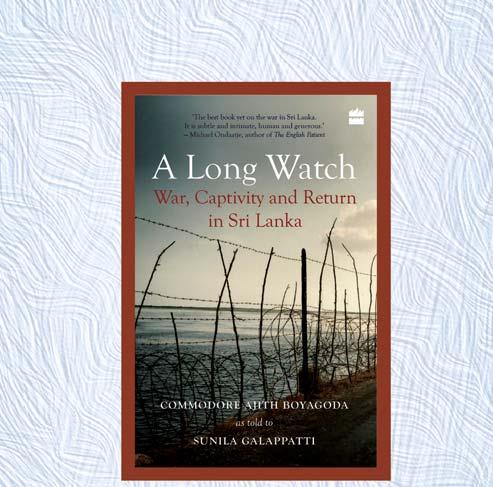


Destiny of Love
The columnist is a children’s writer and senior journalist.

RC Salem, D 2982, in association with Global Education Solution (GES), Australia, which is the certified training partner of RILM, and Indian Career Education and Development Council (ICEDC), Mumbai, organised a three-day Teacher Performance Development Training at the Rotary Hall in Salem. Over 100 teachers from government schools around the region participated. Inaugurated by DG Dharmesh R Patel, the event was extended as a multi-club Rotary meeting on Literacy.
A panel discussion with the CEO Racquel Shroff and Director Jeevan D’Cunha from GES, G Tholkappia Arasu, a Rotarian and Principal, AVS College of Technology, D Ramesh Kumar, Vice-Chairman, CII-Salem, and G Senthilkumar, President of RC Salem Galaxy, helped the District Literacy Committee understand the TEACH process better and frame feasible goals, said R Venkatachalapathy, President, RC Salem.
“If it is a Smart Class the teachers have to know their role. They can’t just play a video lesson and think their job is done. They have to learn to make the class interactive,” he added. The training helped them understand their role

and use the available technology to ensure better classroom participation and the learning outcome of the students.
“It was a valuable programme. I am sure we can improve the classroom atmosphere if we follow what we learnt here with enthusiasm,” said Lakshmi, who teaches at the Sahadevapuram Government Middle School.
Apart from conducting regular training programmes, the club also recognises and appreciates the services of the teachers through the Nation Builder Awards.
Randi Druzin Convention
Toronto has a vibrant music scene that includes all types of venues, from stadiums to small bars, and features every musical genre. When you’re in town for the 2018 Rotary International Convention, from June 23 to 27, take time to hear some live music.

The majestic Massey Hall hosts a mix of classical and contemporary music concerts. Massey Hall was home to the Toronto Symphony Orchestra and the Toronto Mendelssohn Choir until 1982, when they moved to the newly built Roy Thomson Hall.
On June 28, just after the convention, Aretha Franklin is
scheduled to appear at the Sony Centre for the Performing Arts. It’s worth checking the Sony Centre schedule.
The Horseshoe Tavern is the best-known small venue in the city. Since it opened in 1947, many famous faces have appeared on its stage early
in their careers, including the Rolling Stones, the Police and Willie Nelson.
Jazz enthusiasts will want to check out Jazz Bistro, where the music is accompanied by fine dining and The Rex, a decades-old hotel, bar and restaurant where you can hear jazz and blues.
Lovers of Latin music gather at the Lula Lounge to enjoy salsa bands while eating Latin fusion cuisine. Salsa instructors offer lessons on Friday and Saturday nights.
Preregistration discount ends March 31. Go to riconvention.org.
Source: The Rotarian

Kiran Zehra

Speaking of prisoners’ welfare, why not start with giving them access to safe water? asks Sailen Bhowmick, President of RC Tollygunge, D 3291. He is referring to the water purifier the club recently installed at the Berhampore Central Correctional Home, in association with RC Murshidabad, D 3291 and Anir Water Machinery, Kolkata. Earlier, the prisoners would drink water directly from the taps inside the prison. The water here contains
high amount of arsenic, “long-term exposure of which may cause cancer in the skin, lungs, bladder and kidney. It can also cause thickening and pigmentation of the skin,” says Bhowmick, who is a Technical Consultant for the Rural Management Development Department, Government of Sikkim.
Many parts of Sikkim and West Bengal suffer from lack of clean drinking water, he points out. A water treatment and management course
in Germany helped him understand how he could help in providing clean drinking water in the rural areas in his State.
He set up a research and development unit in 2002 and Indianised the German technology he had got trained in. The absorption technology used by the Germans had to be modified to suit the local conditions because “the character of water and the amount of arsenic differed from that of the German water.” After successful research, he decided to put the
technology to use through Rotary. “As club president I asked my members and they agreed. Next we are going to install the purification plants in other schools and hospitals in the region,” he adds.
The Superintendent of the Correctional Home has also confirmed that after the installation of the water purifier, stomach disorders and other health issues due to drinking contaminated water have drastically reduced among the prisoners.

Why am I up one day and down another?” cried the sensitive teenager. The father answered wisely, “It is part of our growth, son. A bird that cannot flap its wings up and down cannot fly.” Who hasn’t gone through bouts of high self-esteem (HSE) and low self-esteem (LSE) at different times in life? We get a promotion, praise, even flattery, up zooms our self-esteem like a rocket. Faced with a job-loss, financial setbacks, criticism, down it sinks like a stone in water.
Each time we rise in self-esteem, we experience what it is to be a god. Each time we fall, we experience what it is to be a fallible human being. And as we flap our mental wings between glory and humility, we learn something precious about ourselves — that we can be resilient and flexible in our approach. As the father put it: we grow.

All would be well if we left it there — the godliness, the humbleness — and moved on. The troubles begin when we allow it to stay with us. Experiences that could be agents of transformation, growth, realisation then become distorted with our emotions getting into the act. Ah yes, our emotions coil around these experiences and we want to constantly draw attention to ourselves — of admiration, adoration, virtual worship which are symptoms of suffering from HSE; or of sympathy, shock, indignation on our behalf which are symptoms of LSE. To draw attention, the one with high self-esteem brags and the one with low self-esteem blames. However, neither state, adopted as a permanent way of being, promotes health. And this is a matter of deep concern.
High self-esteem creates aggression when demands are not met, angry
petulance when attention is withheld and there is this arrogance about one’s imagined superiority over others. The hyped-up mind goes quickly into the fourth gear of histrionics, hysteria, panic attacks and this constant surge of adrenaline can raise blood pressure, cause irritable bowel syndrome, a restless body and fatigue.
Low self-esteem creates mental turmoil, spells of sadness, an obsessive urge to complain, cravings for food, a tendency to see more of the negative in situations and people, including oneself. This constant uneasy undercurrent can lead to depression and nervous breakdowns lowering the body’s immunity which will affect the nerves and heart, with a wildly fluctuating blood pressure.


So, I think, the time has come to work on our emotions. When we are high-strung, our perception also
Bharat and Shalan Savur


distort. Distortion is seeing oneself as worthless. Distortion is also seeing oneself as a gift to humankind. So, we have to go back to our emotions, pay attention to them, cool their feverishness, infuse some balance and maturity into them to uncoil them from the experiences.
If we look deeply into our emotions, we realise that they rise and fall like tidal waves within ourselves because we are so overly self-absorbed — we constantly crave attention, approval, sympathy, adulation and reassurance. Thus, the person with LSE dejectedly reiterates, “I am worthless, I think I am abnormal” and, naturally, pat comes the response from the listener, “Of course
not! You are so good, so intelligent” and so on. The person with HSE says, “When I walk into the room, heads turn!” and comes the response from the listener, “Wow! Yes, you have poise…” etc. There’s no need to judge our self on this excessive craving, all we need to do is focus attention away from our self. You see, our attention has taken the wrong route that is always toward oneself. It is like the eye trying to see itself! That is why so much self-attention strains and pains us.
Look outward. We can start the outward process by looking deeply at our home, appreciating its beauty, its cosiness, its warmth. Appreciation is a sweet embrace — we touch things and conditions that make us happy, safe and secure. Then we look at the people in our life with love and empathy — their kind nature, the courage they’ve displayed when in trouble, their consistency, determination and humour. We extend this loving attention to people who pop in and out of our day — the vendors and workers who labour day after day unceasingly, uncomplainingly and we salute their never-say-die spirit in adverse circumstances.

When you do this daily, the hard crust of your self-constructed cocoon softens and something truly beautiful happens — you realise how much affection you have locked inside you for others. And when you experience this wonderful outflow, your heart smiles and steadies. You feel it and this feeling is simply marvellous. When we look at everybody with appreciation and love, we literally hold our heart in the sweetness and softness of this love and it is deeply comforted and healed.
silent. Be in this soothing presence. Watch your mind not demanding that the Buddha be different, pay attention to you not passing any judgement on this wonderful presence. The Buddha presence is perfectly fine as it is. Feel the harmony in you. Inner harmony indicates a mature, balanced and healthy self-esteem.
Now, practise on other people. Visualise the Buddha-presence in them. No demands, no judgement, hence, no expectations, no tension. Again, feel the harmony. Practise this visualising approach with all your activities as well. This develops an attitude of surrendering self-lowering thoughts and self-promoting thoughts. And you come into your own. A clarity emerges as the emotional mists dissipate. Tips: To ensure your continual ascent to a harmonious way of being, desist comparing yourself to others. And, yes, keep away from folk who try and undermine you at every opportunity.
It is important to hold a steady course and gradually win the mind over towards a stable grounding knowledge — the know(your)ledge that you and every other individual is as is. Each of us has a quality that has a fullness to it rather than quantity that is full of emptiness. That’s why, do not be discouraged. Keep strengthening your inner Buddha presence and come back to your fullness. When the mind is calm and harmonious, the body becomes relaxed and at ease. Then it can do effortlessly any exercise, any activity you choose. Your smile is the sparkling meeting point where mind, lips and eyes synchronise. Your smile is a beautiful equaliser, for it says, “I am okay. You are okay.” And your inner presence shines.


The Buddha presence. We also need to teach our mind to be fair towards our self and everybody — to be understanding and accepting rather than demanding and self-critical. Practise looking in the mirror. Visualise the Buddha-presence in you, tranquil and
The writers are authors of the books Fitness for Life and Simply Spiritual — You Are Naturally Divine and teachers of the Fitness for Life programme.
Designed by N Krishnamurthy
How much time do you spend while selecting or buying a mattress for your bed? And how often do we rotate the sides, or flip the mattress, or change it for a new one? The same question holds true for the pillows we use.
S Sundar Rajan is the Executive Director of Dubai Furniture Manufacturing Company (DFMC) which manufactures high quality mattresses — the Serta brand which is the number one mattress in the US and KingKoil brand, which has a 60 per cent market share in the Middle East.
He says that in the western countries as well as in places such as
tries as well as in such as Dubai, prior to buying a mattress, p eo p le do a lot of r esea r ch
because they feel selecting the right mattress, using it properly and maintaining it, contributes a lot to your wellbeing. “You spend a third of your life on the bed, the amount of time you don’t spend anywhere else daily… be it your car, sofa, or a chair. A good night’s sleep will keep you fresh, energetic, agile and you can look forward to good work the next day. But without a good night’s sleep, you will feel terrible the next day,” he says.
An evolving market
He says that in India, people have just begun to understand the importance of a good night’s sleep;
of a goo d n i g ht’ s s l eep; “youngsters are getting h ea l t h consc i ous, which can be seen
from the proliferation of gyms, but the importance of a good mattress is yet to catch up.” And hence cotton mattresses prevail in India, followed by coir and foam, but a quality spring mattress market is yet to evolve.
He estimates the Indian mattress market at `300-400 crore, excluding the cotton market which is totally in the unorganised sector. The spring mattress market is too small, and the main space in the organised sector is in the coir and foam market, and to some extent the latex market. The ratio is the opposite in the developed world where the spring mattress market is around 90 per cent and the rest only 10 per cent, he says.

But this market has potential to grow and hence his company has entered India with the Serta brand of mattresses, which are basically quality spring mattresses. “We have company showrooms in Bengaluru, Mumbai and have now come to Chennai.” In India they have franchisees in 14 locations and are expanding slowly, Kolkata and
Unlike in the developed world, Indian customers touch and feel, and at the most sit on a mattress. But by mere touching and feeling and sitting on it, you can’t decide. You have to lie down on it and then decide.
S Sundar Rajan, Executive Director, Dubai Furniture Manufacturing Company



the rest s of f east an d no t rt h he as t being on their radar next. “Once people buy it in India, then they realise what t h ey h ave m i sse d , an d t h e wor d o f mouth spreads and the neighbours and friends come to us.”
The range of these mattresses start fr f om 30000forasinglesizeandgoes
from `30,000 for a single size and goes up to `1.5 to 2 lakh. “But the emphasis is on quality, we place a lot of importance on the raw materials that go into our mattresses, which are mainly made of spring. The wire is procured from Europe and the machines to make the springs from the US. There is no compromise on quality.” Next comes foam, which is manufactured in Dubai, using special chemicals supplied by Bayer, Germany, and the fabric comes from Belgium. The foam is made in Dubai and sent to India, where the mattresses are assembled. The workers too are trained in Dubai and then sent to Pune, the DFMC has set up a manufacturing facility with a capacity to make 200 mattresses a day.
Rajan says that though Serta is not yet a big player in the domestic home market, “we are deep into hospitality and most of the five-star hotels in India use our Serta mattresses, because they trust our brand and quality and come
back saying their guests speak highly about the quality and comfort.”
So how important is maintenance of a mattress, and how often should you change one?
“It is very important to change your mattress between 7–10 years, but the period depends on how you maintain the mattress,” says Rajan. He recommends rotating the mattress once in three months; and if it’s a two-sided one “it is very important to flip the mattress once in six months. This will ensure durability and provide proper back support, comfort and feel-good factor. So it is very important not only to buy a good mattress but also maintain it.”
What about the belief that people with back pain should use a hard cotton mattress? “Actually that is a myth; it is not the hard surface that matters.

hospitality
We are deep into hospitality hotels in India use our Serta mattresses, because they trust our brand and quality and come back saying their guests speak highly about the quality and comfort.
hotels Serta mattresses, quality and ygg come back saying their guests

If a person has a back problem and lies down on a soft mattress, the back pain aggravates. Therefore, he should select the mattress that is good for him… we have a range from very soft to very firm… so select your mattress suitably. If you select the right mattress, it will make you sleep comfortably, but it won’t cure your problem.”
So how do you choose a mattress that is right for you?
In the developed world, he says, the customers spend a lot of time in choosing the mattress; they do some research on the internet, before visiting the showroom “and have something in

mind about what kind of product they should buy. Showrooms have a range of mattresses and the customer normally lies down on the mattresses, turn left, or right, and often if only one person has come, he/she returns with the family members, who all try out different mattresses and then decide which one to buy. They even come wearing loose fitting clothes which resemble night wear. It’s a process; they go through the process and finally make a selection.”
But in India, he adds, customers don’t go through this process; “they touch and feel, and at the most sit on it. But by mere touching and feeling and sitting on it, you can’t decide. You have to lie down.”
Rajan rues that thanks to lack of knowledge and awareness, even the very rich people in India have very ordinary mattresses in their homes. “People may have Mercs and BMWs, a fantastic, well-appointed house, but they use a cheap coir mattress, and not a quality mattress which is so important for a good night’s sleep.”
Similarly, the pillow you use is also important. The DFMC makes 12 different kinds of pillows; “if you
People may have Mercs and appointed house, but they use a cheap coir mattress, and not a quality mattress which is so important for a good night’s sleep.
choose the right mattress and pillow, the next day your freshness, energy levels and wellbeing will show that you had a good night’s sleep.”
Also in India, in most homes we buy or make the cot first and then buy the mattress. So how important is the base? “Very important; it is like the foundation of a house. We make two kinds of bases; spring and platform. The platform base is made of Canadian pine wood, it holds the weight of the mattress, supports it well and ensures its durability and costs about 40 per cent of what the mattress costs.”
He adds that many customers come to the showroom, experience the mattress and buy only the mattress. “But they don’t get the same feel, support
and comfort because the base or the cot they use at home is different. And they come back to us unhappy saying they’re not getting the same experience and say your mattress is not consistent. When we investigate, we find that the base is not correct and can’t take the load of the mattress which can be up to 100 kg in weight.
It is interesting to note that the company also makes different kind of mattresses for babies and “our baby mattresses are doing very well in the Middle East. Again, there is an erroneous assumption that for babies you have to buy a very soft mattress. But very soft mattresses are not the most suitable for babies, because the spinal cord is in the formation stage and needs very good support in the early days. The baby should not sink into the mattress; it should be firm enough to provide adequate support to the baby’s spine so it can grow well and straight.”
Also, the baby mattress has some special qualities; the fabric is softer, water resistant, fire resistant, anti-microbial and anti-allergic. The cost is around `20,000.

PDG Vinay Kulkarni will continue to chair the TRF’s WAS-MGI (Water and Sanitation – Major Gift Initiative) Committee formed in 2016–17. The Committee has a goal of raising $25 million over 3–5 years, besides educating Rotarians and Friends of Rotary on the global need for water and sanitation. The Committee also works closely with Endowment/Major Gift Advisors to solicit contributions.
Kulkarni is also a member of TRF Fund Development Committee since July 1, 2017. His term ends in 2020.
Kiran Zehra
A job fair conducted by the Rotarians of D 3141 in Mumbai helped unemployed get jobs, providing better livelihood for their families.
She was always worried about telling prospective employers about her physical disability. “I would call them, schedule an interview. But the fear of them seeing me in a wheelchair and rejecting me for my disability never let me attend the face-to-face round,” says Priyesha Krishan Sarang. Bound to a wheelchair since the age of 13, she never dreamt that attending the Rotary Rozgar Mela will transform her life forever. She is now employed at Eureka Forbes’ Euroable — India’s first state-of-theart call centre manned and operated by differently-abled people — and has even drawn her first salary.
The Rotary clubs of D 3141 jointly organised a mega job fair during Sept 16–23, 2017 in Andheri, Matunga and Mulund, attracting people from all walks of life. Eureka Forbes, Blue Dart, LIC India, and 90 other companies participated in the job fair, offering pay-packages ranging from `1.4 to `3 lakh per annum. However, of the 3,000 candidates, only 1,000 cracked the interviews and were shortlisted by the companies. Appointment letters were handed over on the spot to 650 candidates with the LIC hiring 230 employees.
“For over five months we planned and promoted the job fair across
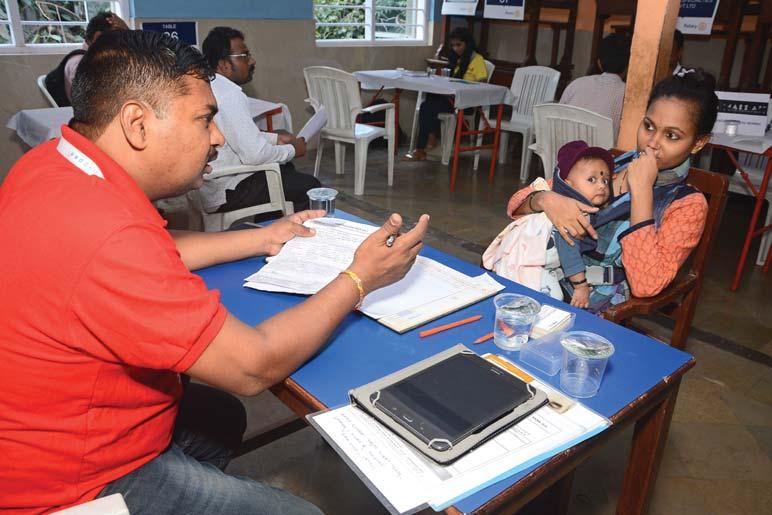

I would schedule an interview, but the fear of them seeing me in a wheelchair and rejecting me for my disability never let me attend the face-to-face round.

Mumbai, in print and on the social media — WhatsApp groups and Facebook posts — to ensure that the event attracts anyone looking for a job,” says District Secretary Girish Mittal.
Keeping in mind that the main purpose of the fair was to provide jobs to the unemployed youth the Rotary Rozgar Mela was kept informal with “no suits and no boardroom. All employers and employees sat face to face. They could walk-in in casuals and discuss the job profile and work culture of the organisation they were aspiring to work for. Employers met potential employees, which saved valuable time in the recruitment process.”
“I could discuss my condition spot-on across the table with my employer as I knew that support and adjustments were available,” says Priyesha. Praising her employer, she adds, “they have special workstations exclusively for people in wheelchairs. However, from qualifying for the job to growth in career, we are evaluated on strict performance metrics. There are no concessions in that.”
Some employers have also encouraged their newly recruited staff to take advantage of their skill development programmes, post hiring. Pankaj S Hande from Mulund who has been hired by IT Source Technology says, “These training programmes will help me stay updated with current software trends and enhance my career growth.”
For Shripad S Bane, who has been hired as a security person at a private company, this job fair has given him back his “ zindagi. Now I can send my daughter for dance class. Uska bada mann tha (she wanted to learn) but I did not have the money. I can’t thank Rotary enough for this job.”
DG Prafull Sharma appreciated and thanked all the clubs and Rotarians of D 3141 who contributed in making this Rozgar Mela a success. This project is now going to be an annual affair.

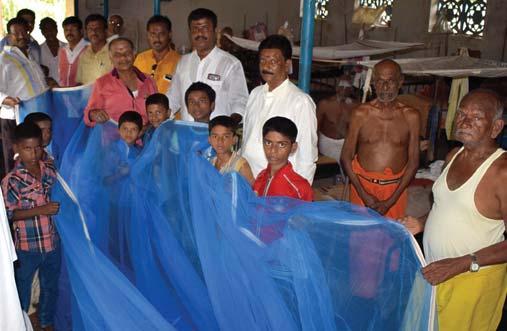
Aquiz competition was held in which 850 students from 15 higher secondary schools in the city took part and displayed their knowledge on diverse subjects.

The club donated ceiling fans and mosquito nets to Suddha Sanmarkha Payirchchi Nilayam, an NGO which provides food and shelter to 70 orphans and over 40 homeless people in Cuddalore.

Asub-junior badminton tournament was organised in which 80 players from different schools took part. This was held as a promotional event for the juniors.
An ambulance van was donated to the community and it will be maintained by Jan Sewa Dal. The vehicle will be used to carry underprivileged patients to the hospitals. It will help more than 500 patients every year benefitting the working class in this textile town.

Allahabad North — D 3120
Forty sweepers of a ward in Allahabad were honoured with clothes, towels and household items as part of Diwali celebrations.

Adental and haemoglobin check-up camp was held for children at Malawali. Dental procedures were performed and dental kits were distributed to the children.

Aborewell was installed at the club’s adopted school which would benefit 15 nearby villages. The project cost `65,000 and the school had sent a letter of appreciation thanking Rotary for solving water shortage in the locality.

The club organised three health camps in which 300 people were screened and free medicines were given to the patients. Fifteen people were recommended for eye surgeries.
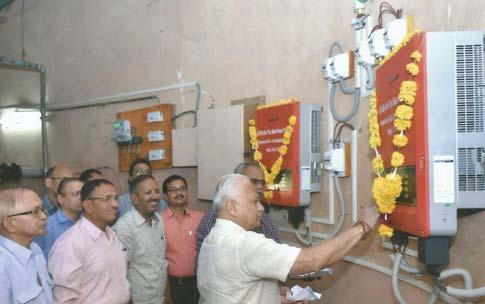
Sangli
legislator Sudhir Gadgil inaugurated a rooftop solar power project. The project was executed in association with The Rotary Silver Jubilee Trust.


Ahealth camp for garment industry workers was held with the help of a government hospital in which nearly 150 people were screened for various ailments.

Afive-day eye camp was held, in partnership with the NHAI, in which spectacles were distributed to 400 truck drivers at Karajeevanahalli in Sirsa taluk. Ten optometrists from Globe Eye Foundation Hospital, Hosakote, screened the patients. The total cost of the project was `2 lakh.

The National Library Week was celebrated at the Udumalpet library. Club President S Nagaraj inaugurated the event. A science exhibition was also held for school students.

Under the Hope Project, an operation theatre at the Alleppey General Hospital was renovated at a cost of `1.5 lakh. It was inaugurated by Municipal Chairman Thomas Joseph and the plaque was unveiled by DG Suresh Mathew.

An awareness rally on dengue was organised with nearly 500 students taking part in it. The event received support from the district administration, Corporation and the health department.


An e-learning kit was donated to government higher secondary school in Gudiyattam under the Schools into Smiles project. DG K Jawarilal Jain presented the kit to the school authorities. The project will benefit nearly 400 students.

In partnership with RC Birtamode Midtown, D 3292, the Rotarians distributed new clothes, under the theme Maitri, in Nepal. Club President Ashish Gupta, along with Rotarians from both the clubs, distributed stationery, medicines and sanitary items to the underprivileged and schoolchildren.

AHappy School project was completed at Adarsh Madhya Vidyalaya. District Magistrate Chandrasekhar Singh inaugurated four renovated toilets, new water facilities, library and handed over sports equipment to the faculty. Over the last few months, the club provided several other facilities also for the school.

Mosquito nets were distributed at the dengue-infested area of Picnic Garden in association with Ganasasthya Committee of Young Stars Club. The initiative scaled up the public image of Rotary in the neighbourhood.

Amega health camp, along with a food distribution programme, was organised for the flood victims in the Marchawar area. All the clubs participated in the project benefitting over 800 people who were given free medicines after a health check-up.
Compiled by V Muthukumaran
Designed by L Gunasekaran

Last year I wrote a book. The publisher asked me if I wanted to have the now-customary “book launch”. I said no, because to me they are a completely unnecessary marketing innovation. They don’t really boost sales because — pardon me for saying this — most of the people who attend book launches are not the types who read. They merely come to be seen. Only around a fifth of those who attend buy the book. That at best comes to around 50–75 copies. The rest simply gobble the sandwiches and samosas and sip the tea. A few even leave before the event has started but not before they have been seen by the author. People sliding off without buying is perfectly rational because who is going to remember, anyway?
The economics of these launches is interesting. In Delhi’s centre of intellect, the India International Centre, it costs around `30,000 to invite
A few people even leave before the event has started but not before they have been seen by the author. People is perfectly rational because who is going to remember, anyway?
200 people for the pre-launch tea. Sometimes, if you are a celebrity author, the publisher may throw in a post-launch celebratory cocktail. This costs around ` 60,000. And if you are a real celebrity, with knobs and bells, there is even a small dinner for about 50 people where scotch and fried prawns are served — as mere starters. Many people calculate that paying `500 for a book in return for free, unlimited scotch is good value for money, especially as the book can be sold for half price the next day or gifted to someone you owe a gift.
In the last seven years, I have been to just three such launches because the books were written by very good friends. Later, I asked each of them, two of whom are very shy and retiring sort of men, why they had agreed to the “launch”. They said the publisher had harassed them to have one. My publisher left me alone after I, like Julius Caesar, said no three times.
Much also depends on the advance paid to the author. The higher it is, the more is the need to market the book so that the advance can be recovered. The launch is thus calibrated according to the advance: the costlier the postlaunch feeding, the higher must have been the advance. The venue, too, is a dead giveaway. A five-star hotel launch probably means a huge advance has been paid. A college auditorium launch, on the other hand, means not only that no advance has been paid it is the poor author who is paying for the tea and (glucose) biscuits.
Then there are the so-called heavy weight speakers who are invited to
Most speakers, after saying how wonderful the book is, speak largely about what they think about the world rather than what the author has to say.
talk about the book. Here I must share a dreadful secret. One of them told me once that he had not actually read the book and had winged it after hastily glancing through the text on the jacket flap matter. I wonder how common this is. Very, I think because most speakers, after saying how wonderful the book is, speak largely about what they think about the world rather than what the author has to say.
There is another problem: As a speaker, or even as an attendee, can you tell the gathering that it is a rotten book? Wouldn’t that be like telling a bridegroom on his wedding day that he looks a perfect idiot?
Meanwhile, publishers and authors have lost sight of a vital aspect of book promotion: the well-written review. However, authors value such reviews far more than the bukbuk at launches. Besides, in today’s digital world, reviews have become invaluable because you can buy the book almost at once after reading the review.
Klik, klik, klik.
Bought.

Taisei, a Japanese firm, is planning to use drones to force overworking employees out of the office after working hours. The drone will fly through the office and play the Scottish song, Auld Lang Syne, hovering over the employees, forcing them to go home. Japan has for years been trying to curb excessive overtime which is causing health issues in employees. However, a professor at the Osaka University opines that workaholics may take their unfinished assignments home and recommends reducing workload and hire more workers instead.

UK now has a minister for tackling loneliness and combatting social isolation. Tracey Crouch, presently the minister for sports and civil society, has been appointed by the British Prime Minister Theresa May to take on the additional post created in memory of slained Labour MP Jo Cox who dedicated herself passionately to help those battling social isolation. Studies reveal that more than nine million people often feel lonely while 200,000 older people have not had a conversation with anyone in over a month. Tracey will carry out the recommendations of the Jo Cox Commission on Loneliness and create a fund to design activities that connect people.


You can start a shower, adjust the water temperature, fill the bathtub and warm a toilet seat — all this with a command to Amazon’s Alexa installed on your smartphone. What’s more, Kohler is also coming up with smart lids for toilets that will automatically open as you approach. The company displayed its digital assistants at a CES show in Las Vegas. Sure, it might feel ridiculous to command your toilet to flush itself. But with the advent of more voice assistants into homes and lives, creating a living space that’s responsive to vocal and gesture controls will probably feel natural in the coming years.

Welcome to Sudharma, the ISO-certified home of the Suranas. Here every activity functions on clockwork precision and every item is listed meticulously to the last ‘T’. Their Quality Policy stipulates that the home is committed to providing effective, need-based food catering, housekeeping and facility management services at all times. In line with the ISO guidelines, each family member is assigned a designation and role; every room also has a name — the kitchen is Annalakshmi; dining room is Trupti; puja room is Kevalyadham; children’s room Sishu Kutir and so on. The family is expected to show improvement in various parameters, including health.
In a winning gesture, Canadian Prime Minister Justin Trudeau celebrated Pongal wearing a kurta and a traditional veshti. He greeted Canadian Tamils with “Iniya Thai Pongal Nalvazhthukkal! (sweet Pongal greetings)”, in his Facebook post, which garnered over 21,000 ‘likes’ in just six hours. On Jan 14, he also shared a video to wish the Tamil population in Canada a happy Pongal. The Mayor of Toronto, John Tory, joined Trudeau in preparing Pongal.
Regn. No. TN/CCN/360/2018-2020 Licensed to post without prepayment No.TN/PMG(CCR)/WPP-431/2018-2020
Registered with Registrar of News Papers for India 3880/57 Rotary News Published on 1st of every month
Total number of pages in this monthly issue, including cover, 84. Price: `35








Serving others is pretty much reflexive for Rotarians, whether it’s spreading hope or orchestrating critical connections. When the husband of Lesley Barmania, a Rotarian from Canada, became seriously ill in Korea just after they attended the 2016 convention, fellow Rotarians put her in touch with In-Seok Kim, a Rotarian from Busan, who launched an emergency blood drive for her husband’s rare type. The connection proved to be lifesaving.
Find your inspiration at the Rotary Convention in Toronto. Register today at riconvention.org.













ROTARY CONVENTION 23-27 JUNE 2018


